With its sprawling plains and pristine lakes, Montana offers a diverse and abundant habitat for wildlife, including ducks. Ducks are common in the state and vary depending on the season. Discovering these diverse waterfowl is a treat for bird watchers.
This guide unveils the 27 Montana ducks, from puddle ducks to diving ducks and sea ducks. Learn the best spots and times to see these magnificent waterfowl.
- Related article: Encounter Montana’s Wildlife
Are you curious about their behavior? We’ll introduce you to the unique traits and fascinating facts of Montana’s duck species as they navigate the state’s waters. For birdwatchers, photographers, and nature enthusiasts alike, observing these ducks offers a captivating glimpse into their beauty.
5 Key Takeaways on Montana Ducks
- Montana is a birdwatcher’s paradise with ducks year-round, additional summer visitors, and specific winter and migration periods.
- Montana’s ducks are categorized as puddle ducks, diving ducks, and sea ducks.
- Puddle ducks feed by tipping in shallow water to reach vegetation from the surface. They include the American Wigeon and Blue-Winged Teal, each with unique features and behaviors.
- Diving ducks typically feed by diving into the water. They are usually found in large, deep bodies of water, such as lakes. One common diving duck in Montana is the Canvasback, often called the aristocrat of ducks.
- Sea ducks are diving ducks that have resided in coastal waters for most of their lives.
Montana Duck Sightings by Season
| Season | Ducks |
|---|---|
| Year-Round | Mallard, Gadwall, American Wigeon, Green-winged Teal, Northern Pintail, Bufflehead, Ring-necked Duck, Lesser Scaup, Redhead, Hooded Merganser, Barrow’s Goldeneye |
| Summer | Northern Shoveler, Cinnamon Teal, Blue-winged Teal, Wood Duck, Ruddy Duck, Canvasback, Harlequin Duck |
| Winter | Greater Scaup, Common Goldeneye, Common Merganser, Long-tailed Duck, White-winged Scoter, Black Scoter |
| Migration | Eurasian Wigeon, Red-breasted Merganser, Surf Scoter |
Montana is a birdwatcher’s paradise, offering a home or a rest stop to various ducks throughout the year. The state’s diverse landscapes and habitats play a key role in the availability of birds by season.
This gives you a glimpse into the dynamic of Montana’s bird species in the state’s vast skies and waters. Whether you’re a seasoned birdwatcher or just starting, knowing the availability of birds by season enriches your experience. It also highlights the importance of preserving these animals’ natural habitats.
Montana Puddle Ducks
Montana is home to various ducks that love the state’s waters. Puddle ducks, also known as dabbling ducks, are a common sight. These ducks feed by tipping up in the water and raising their tails. Let’s meet some of the puddle ducks you can find in Montana.
1. American Wigeon
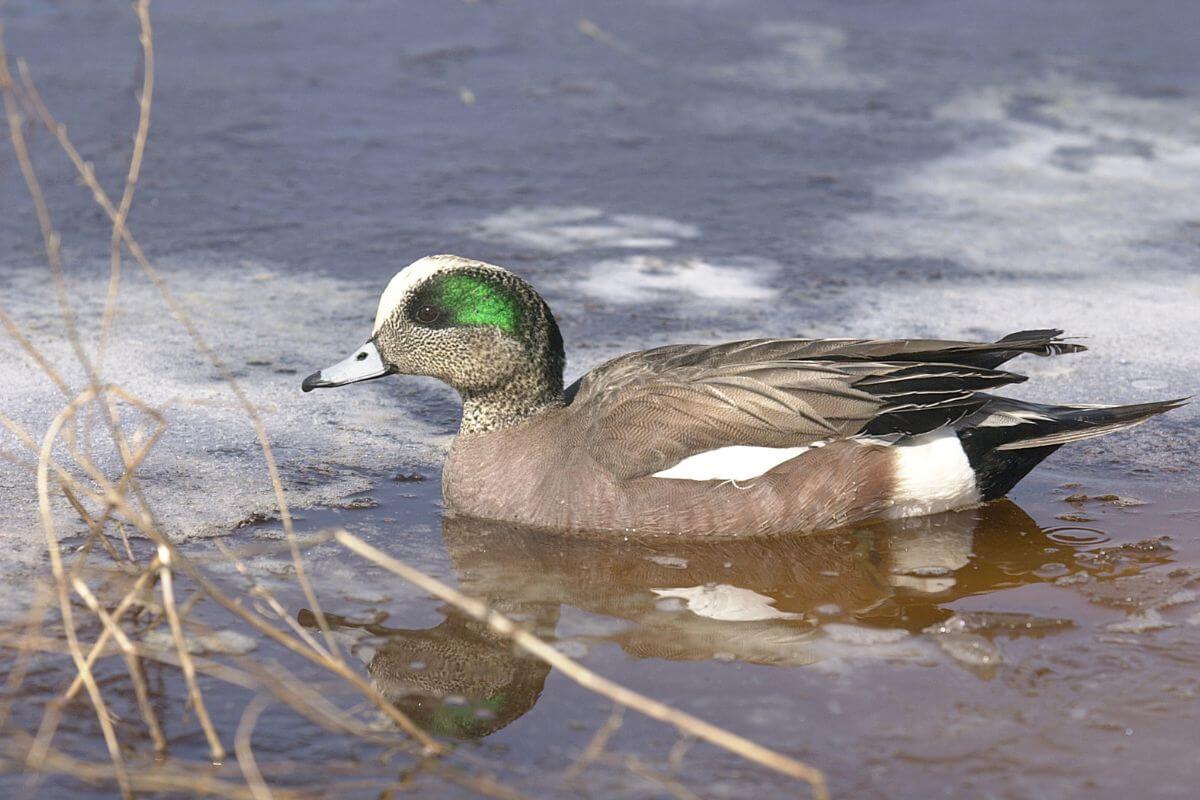
| Key Characteristics | Details |
|---|---|
| Scientific Name | Mareca americana |
| Habitat | Sloughs, ponds, small lakes, marshes, and rivers |
| Food | Stems and leafy parts of aquatic plants |
| Color | Grayish-brown |
Known for their unique features and distinctive sound, American Wigeons are a common sight in Montana throughout the year. If you’re out and about from March to June or September to November, keep an eye out for these compact ducks.
During the breeding season, the males are unmistakable with their green eye patch and white crown, earning them the nickname “baldpate.” The females are still easily recognizable, sporting a more subdued color palette of warm browns and grays.
Here are some tips for spotting these interesting waterfowl:
- Listen for their nasal whistle. It’s a sound you won’t forget and often the first sign that American Wigeons are nearby.
- Watch quietly from a distance. American Wigeons are a bit skittish and tend to fly off if they sense danger, so keeping a quiet and respectful distance will give you the best chance to observe them.
Now, let’s dive into some fascinating facts about the American Wigeon:
- Diverse Diet – American Wigeons are unique in their diet, especially among dabbling ducks. They consume a larger proportion of plant matter, allowing them to reach deep underwater vegetation. This is thanks to their specially adapted bill that’s more like a goose’s.
- Rare Guests – Now and then, you might spot a rusty-headed Eurasian Wigeon in a flock of American Wigeons. This bird is a rarity in these parts but highlights the diversity of wildlife in Montana.
The American Wigeon’s unique characteristics and habits are standout features of Montana’s wildlife. Keep the surroundings peaceful when looking for them, and enjoy the beauty of these quiet lakes where the “baldpates” roam.
2. Blue-Winged Teal
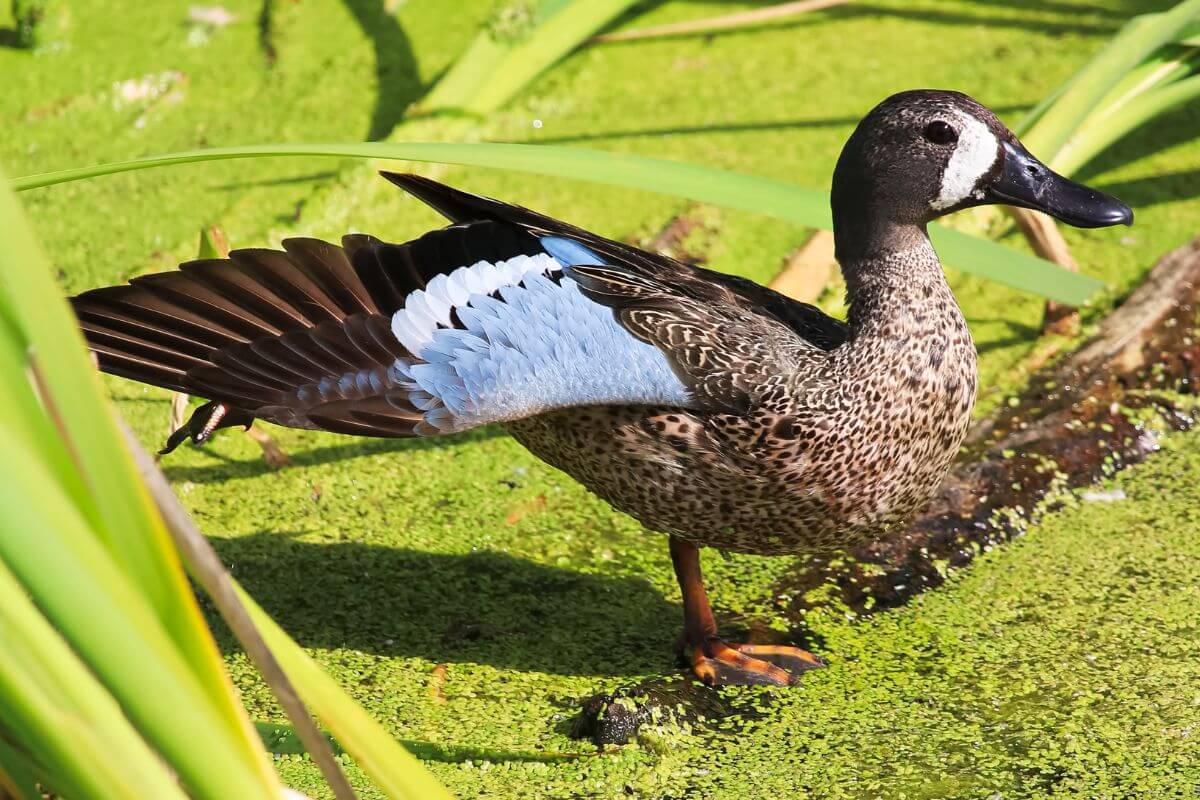
| Key Characteristics | Details |
|---|---|
| Scientific Name | Spatula discors |
| Habitat | Shallow ponds |
| Food | Aquatic invertebrates, seeds, aquatic plant materials |
| Color | Patterned brown |
Blue-Winged Teals bring a burst of color to Montana’s ponds and lakes. These ducks are a sight, especially from mid-March to November when they visit. The females and eclipse males might blend in with their cold, patterned brown feathers on the ground. But a stunning powder-blue patch on their wings is revealed once in flight.
Blue-winged teals are not just pretty birds but are known for their long migrations. However, this journey is not without its dangers. They fly over the ocean for miles, resulting in having the highest mortality rate among dabbling ducks.
In Montana, places like Freezeout Lake offer a nice pond for the Teals to stop, rest, and feed. It’s a perfect spot, except for one problem: skunks. Yes, skunks were a major issue for the Teals’ nests, making it hard for them to have babies that would grow up safely.
When you spot a Blue-Winged Teal in Montana, you might see them hanging out with other dabbling ducks. They like chilling at the edge of the water, hidden under plants. This is how they stay safe while looking for food or taking a break.
3. Cinnamon Teal
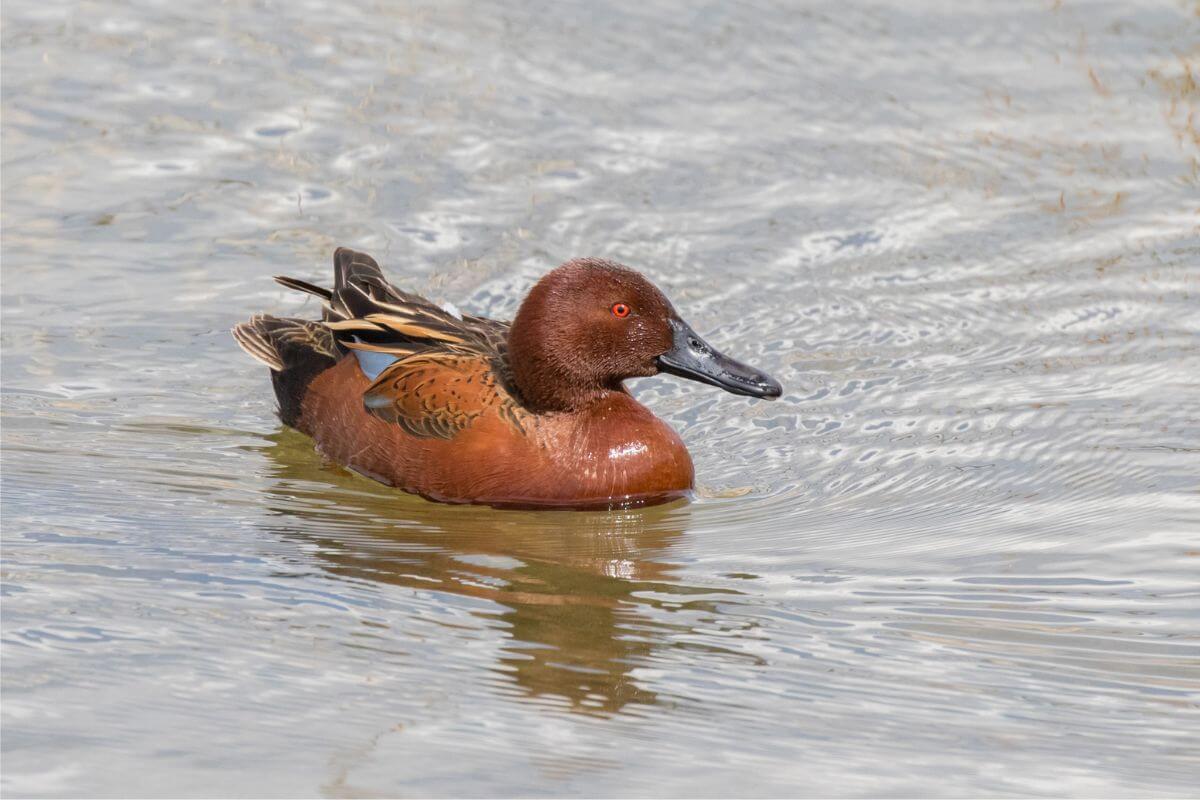
| Key Characteristics | Details |
|---|---|
| Scientific Name | Spatula cyanoptera |
| Habitat | Wetlands including marshes, streams, ponds |
| Food | Seeds and aquatic vegetation |
| Color | Mostly rich brownish overall |
The Cinnamon Teal is a striking waterfowl species that grace Montana with its presence, typically seen during the summer months from March to mid-November. Here’s a closer look at their appearances:
- Breeding Males – Breeding male Cinnamon Teals are showstoppers with red eyes, long dark bills, and vibrant rusty plumage. They sport a brownish back, a white underwing, and a sky-blue patch in the open wing, a common feature among teal and shovelers.
- Females, Immatures, and Non-Breeding Males – Cinnamon teals are more subtly beautiful, especially in females, immature males, and non-breeding males. They are covered in rich brown tones that help them blend in, and they, too, have a distinctive sky-blue wing patch.
Some fascinating facts about the Cinnamon Teal:
- Vibrant Look – Aviculturalists, or waterfowl fanciers, are particularly fond of Cinnamon Teals for their looks. It’s not uncommon for them to be part of collections, and sometimes, they find their way back to the wild after escaping.
- Hard to Identify When Breeding – Identifying non-breeding teals can be challenging as they lose their vibrant colors. However, the males molt back into their reddish plumage by mid-winter, making them easier to spot.
- Bill Size Is a Key Feature – The Cinnamon Teal has a longer and wider bill than other teal. This is a key feature for telling them apart, especially from the Blue-Winged Teal.
Cinnamon Teals often feed at the edges of shallow wetlands and mingle among rushes, sedges, and reeds. The best times to spot them are early in the morning or late in the afternoon. A spotting scope can be a handy tool for bird enthusiasts.
4. Eurasian Wigeon
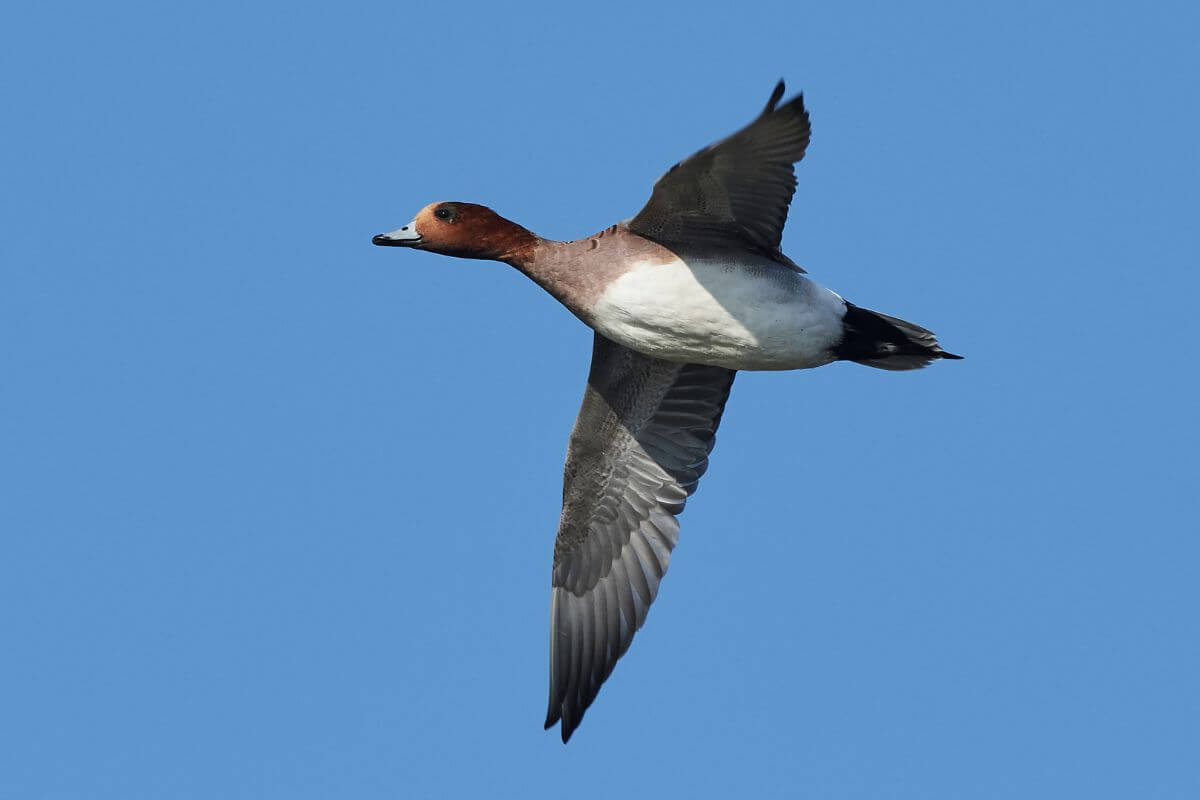
| Key Characteristics | Details |
|---|---|
| Scientific Name | Mareca penelope |
| Habitat | Lakes and ponds |
| Food | Plants |
| Color | Gray and brown |
Spotting a Eurasian Wigeon in Montana is a rare and special event, as these elegant birds are not your everyday sight. In fact, seeing one is so uncommon that there are usually fewer than 10 sightings a year. They visit Montana briefly in the spring, as they migrate from March to April.
Here are some key points to help you understand and maybe even catch a glimpse of this special waterfowl:
- Spotting – Look for Eurasian Wigeons among groups of American Wigeons. Because they are game birds, they are a bit skittish, so it’s a good idea to stay in your car or use a spotting scope.
- Migration – Eurasian Wigeons in Montana likely come from Iceland (if in the east) or eastern Asia, near Russia (if in the west).
- Behavior – Eurasian Wigeons feed by dabbling in the water and diving to find their meals underwater. This is where they get food, such as plants and other water-based treats.
- Origin of Name – The name “Penelope” in Eurasian Wigeon’s scientific name comes from Greek mythology. Penelope is Odysseus’s wife, and the story goes on to say that she was saved by a duck when she was thrown into the ocean.
- Courting Rituals – Male Eurasian Wigeons have a unique way of courting females. They gather in groups and show off with lively head and wing movements to impress the ladies.
Seeing a Eurasian Wigeon is not just a birdwatching opportunity. It’s a chance to witness a creature with a unique story and set of behaviors. Remember, patience and a little knowledge about where and what to look for can make all the difference.
5. Gadwall
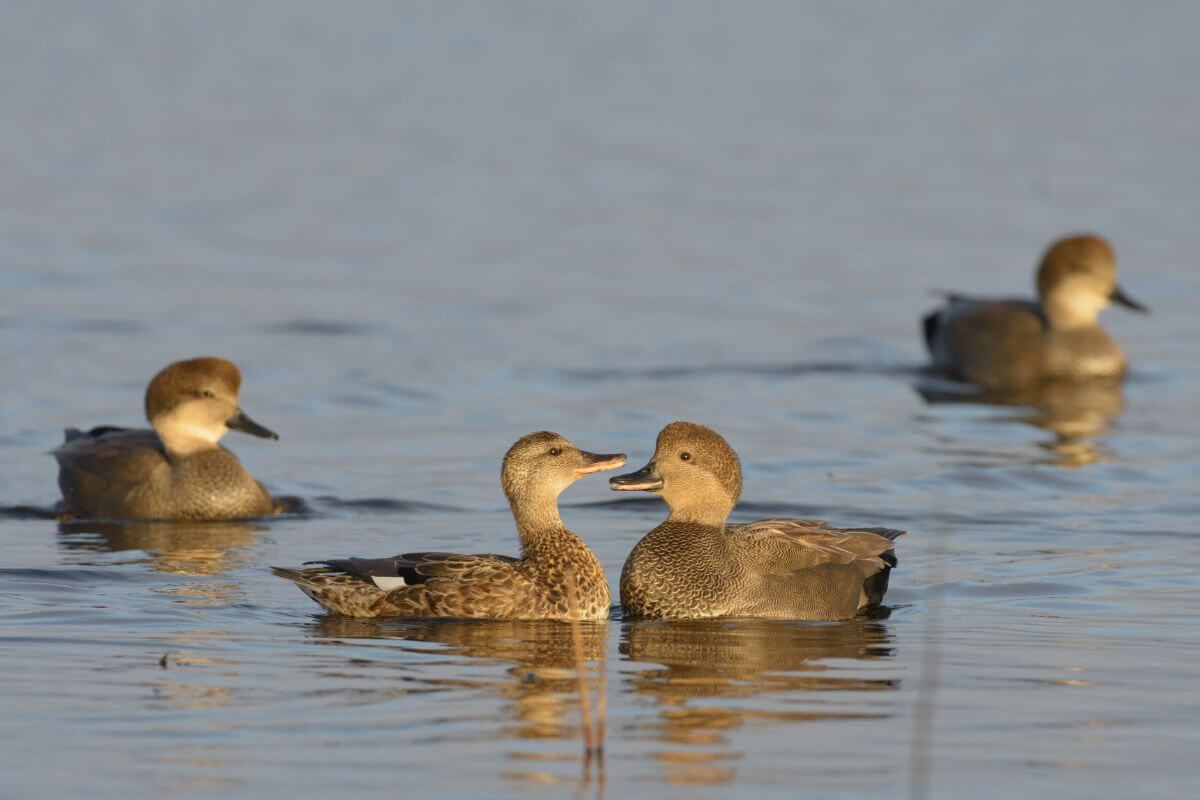
| Key Characteristic | Details |
|---|---|
| Scientific Name | Mareca strepera |
| Habitat | Saline lowlands |
| Food | Submerged aquatic vegetation, seeds, and aquatic invertebrates |
| Color | Gray-brown with a black patch at the tail |
When you’re in Montana, keep an eye out for Gadwalls, especially when they’re flying through during their migration. These ducks are pretty cool with their unique habits and features. Here’s what you need to know to spot them:
- Looks – Gadwalls are medium-sized and easy to spot, with white bellies and small white patches on each wing. The males have a stylish gray and tan outfit with a touch of pale, gray-brown on their heads and a sleek black beak.
- Hangouts – Gadwalls chill on small water bodies with lots of plants. They prefer slightly deeper water than their duck pals.
- Pirate Habits – Gadwalls have a habit of stealing food from diving ducks and coots. It’s not what you’d expect from a duck, but nature is full of surprises.
- Unique Calls – Instead of the typical quack, Gadwalls make a nasal, rasping sound that goes like, “reh reh reh reh.” It’s their way of saying hello, I guess.
- Nesting – When it’s not about food or flying, Gadwalls nest on the ground in areas with tall grass. They make their homes in shallow scrapes, keeping them well hidden.
Gadwalls are fascinating creatures, adding a touch of adventure to Montana’s waters with their pirate-like behavior and distinctive calls. So, next time you’re out bird watching, listen for their duck sounds and see if you can spot these unique ducks.
6. Green-Winged Teal
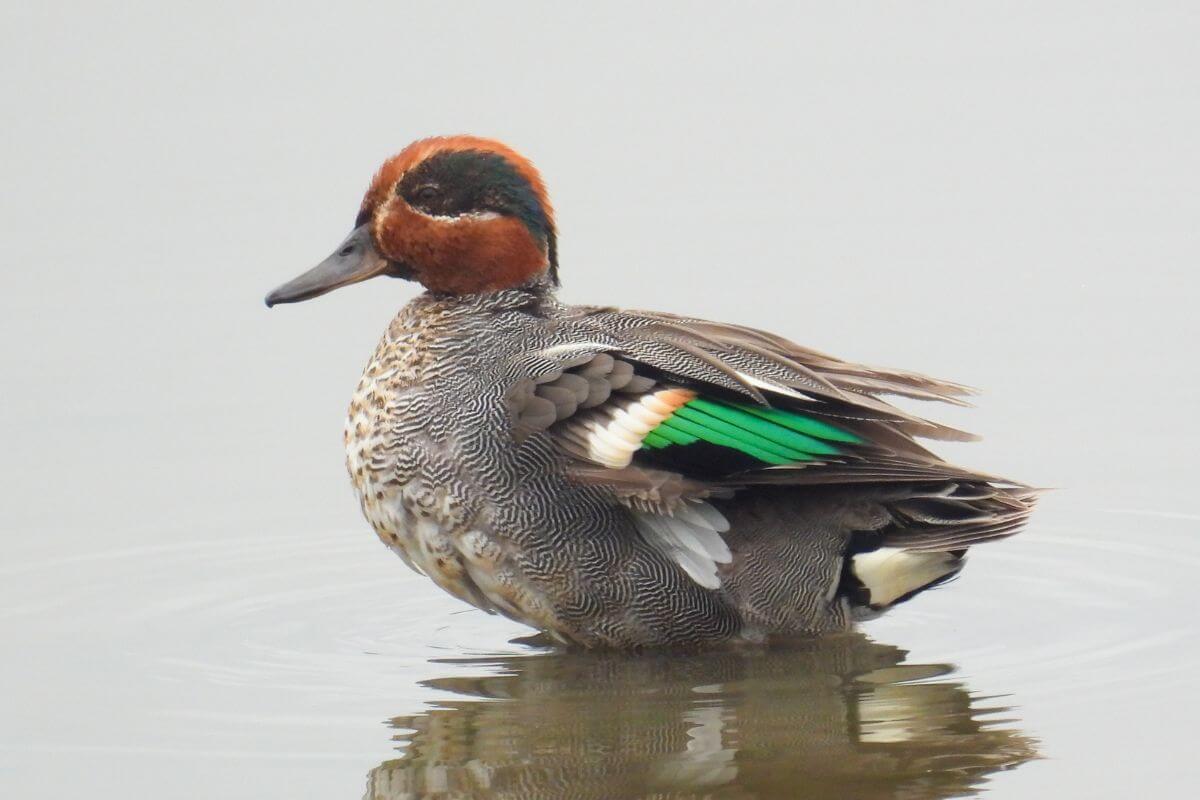
| Key Characteristics | Details |
|---|---|
| Scientific Name | Anas crecca |
| Habitat | Wooded ponds of deciduous parklands |
| Food | A broad diet including seeds and aquatic vegetation |
| Color | Grayish to brown with green wing patches |
Green-Winged Teals are delightful small dabbling ducks in Montana, available all year round. They feed on lots of vegetation by tipping up in shallow water or picking at food while standing in wet areas. This diet is perfect for their preferred habitat, in shallow ponds and flooded fields
The adult male Green-Winged Teal stands out with its gray body and striking white stripe running from the waterline to the shoulder. The cinnamon head with a bright green patch extending from the eye to the neck is also visible in good light.
On the other hand, the females sport a more subtle look with their brown feathers and a yellow streak near the tail. Both males and females have green patches on their wings, visible when they take flight.
Here are some key points to remember about the Green-Winged Teal:
- Smallest Ducks – Green-Winged teals are the smallest dabbling ducks in America, making them quite unique.
- Narrow, Short Bill – The narrow, short bill of the Green-Winged Teal sets it apart from other ducks.
- Cousins Previously Considered Different Species – The American and Eurasian Green-Winged Teals were formerly considered different species.
Finding these ducks is a treat. Listen closely, and you might hear the male’s distinctive whistle, quite different from what you’d expect from a duck.
7. Mallard

| Key Characteristics | Details |
|---|---|
| Scientific Name | Anas platyrhynchos |
| Habitat | Uplands close to water |
| Food | Aquatic invertebrates |
| Color | Brown to mottled brown |
Mallards are a common sight in Montana, sticking around all year. They are the most abundant duck species in North America. What makes them so successful? Their knack for fitting into different duck homes, their toughness in the cold, and how they deal with us humans.
Some cool Mallard facts:
- Most domestic duck breeds come from Mallards, but they look slightly different and are heavier.
- The loud quack you hear is from a female Mallard. The males? They make a softer, rougher duck sound.
- People have been hunting Mallards for a long time, including in Montana.
You can find Mallards in local parks, where they might just visit you for a snack. For a more natural view, head to a nice pond or lake. There, these adaptable ducks are usually the ones you see the most.
8. Northern Pintail
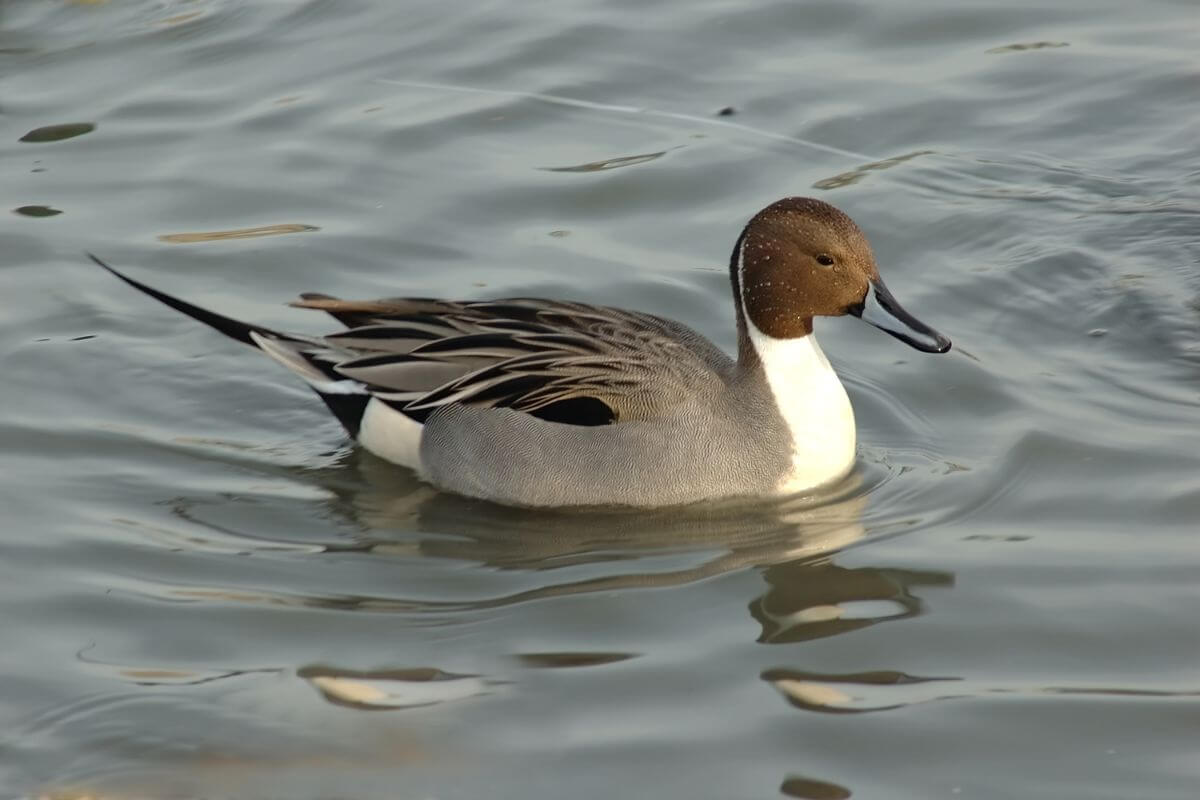
| Key Characteristics | Details |
|---|---|
| Scientific Name | Anas acuta |
| Habitat | Open country with wetlands and low vegetation |
| Food | Grains, aquatic plant seeds, aquatic insects |
| Color | Chocolate brown head and neck |
Northern Pintails are a sight in Montana, where they grace the skies and waters with their elegant presence. These prominent pintails call Montana home all year but are most easily spotted during their migration periods. Watch for larger numbers from March to May and October to November.
Here are some fascinating facts that set the Northern Pintail apart:
- Distinct Ducks – Both male and female pintails are easily recognized by their slim bodies, long necks, and pointed tails. Males sport a distinctive white stripe on their necks and stand beside the intricately patterned females.
- Night Flyers – During migration, Northern Pintails take to the skies at night, reaching up to 48 miles (77 km) per hour.
- Social Butterflies – In the off-breeding season, Northern Pintails form large groups and are quite sociable, often seen mingling with other duck species.
Head to the National Wildlife Refuges for a guaranteed Northern Pintail sighting. Look in shallow waters and nearby fields, especially for groups of ducks standing taller than the rest. Remember these insights as you explore Montana’s wetlands and lakes. You might just spot one of these graceful ducks.
9. Northern Shoveler
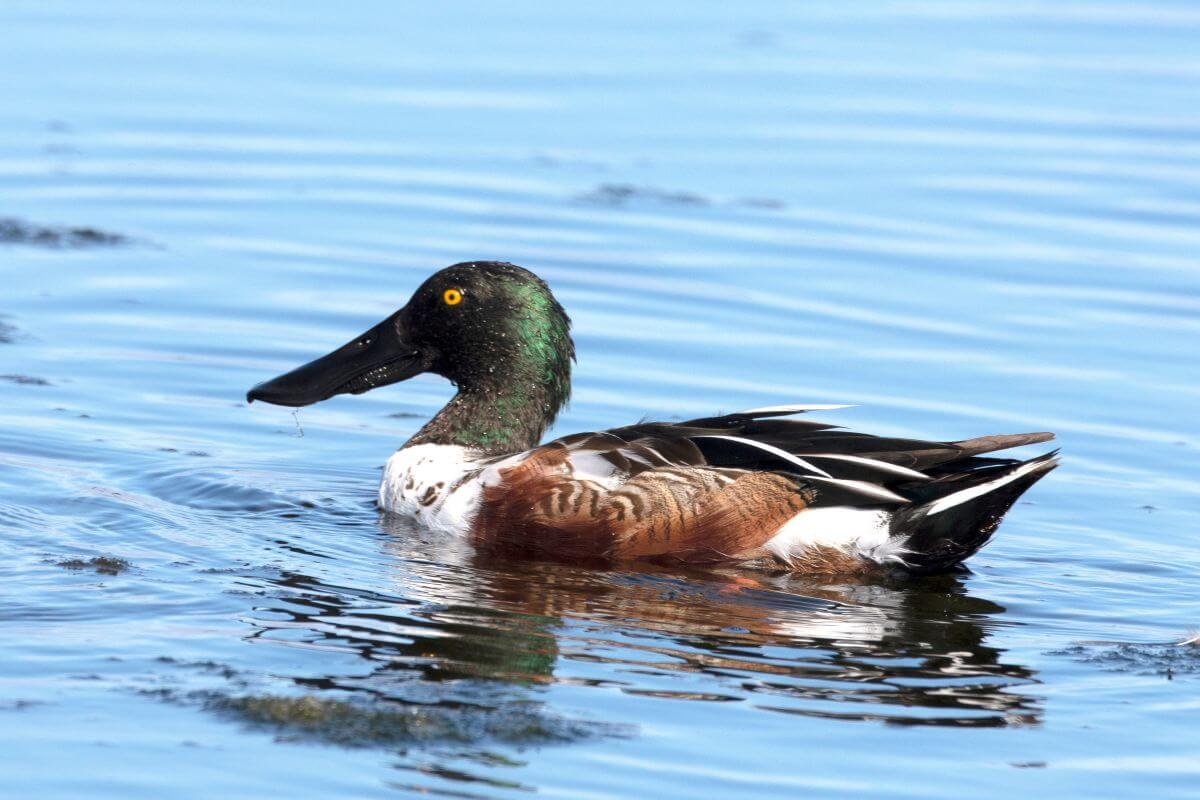
| Key Characteristics | Details |
|---|---|
| Scientific Name | Spatula clypeata |
| Habitat | Marshy borders of lakes and ponds |
| Food | Aquatic plants and small aquatic invertebrates |
| Color | Bold white, blue, green, and rust to brown and blue |
When you’re out looking for ducks in Montana, the Northern Shoveler is a must-see. March to November is the best time to spot them, with April being prime time. Their favorite spots include shallow wetlands, especially in National Wildlife Refuges.
Why are Northern Shovelers interesting? Well, for starters, they are:
- Less Shy – Northern Shovelers are less wary than other ducks, meaning you might get a close look at them without binoculars.
- Shovel-Shaped – Northern Shovelers’ bills are huge (about 2.5 inches) and shaped like shovels.
- Monogamous – Northern Shovelers stick together longer than most duck pairs.
- Smart – Female Northern Shovelers often defecate on their eggs when they leave their nests to keep them safe.
Spotting Northern Shovelers is not just about seeing a duck. It’s about witnessing a unique part of nature’s creativity.
10. Wood Duck

| Key Characteristics | Details |
|---|---|
| Scientific Name | Aix sponsa |
| Habitat | Wide variety of habitats, including creeks, rivers |
| Food | Seeds, fruits, and aquatic and terrestrial invertebrates |
| Color | Colorful plumage to gray-brown |
Wood Ducks are a year-round treasure in Montana, but they truly shine from March to October. They stand out as one of the most visually stunning waterfowl you can find. The males boast vibrant chestnut and green colors, adorned with intricate patterns on every feather. Not to be outdone, the females rock a chic look with a white pattern around their eyes.
Here are a few fascinating facts to impress your fellow bird-watchers:
- Strong Grippers – Wood Ducks have strong claws that can grip bark and hang out on branches.
- Double Brood Raisers – Wood Ducks are the only ducks in North America that can raise two duck broods in one year.
- Unique Ducks – Wood Ducks sport a unique shape, with a crested head, thin neck, and long and broad tail.
If you’re looking for Wood Ducks, your best bet is around the outskirts of swamps, lazy streams, beaver ponds hidden by foliage, and the fringes of marshes. They’re not big fans of wide-open water, so you’ll likely spot them in these cozy spots.
Montana Diving Ducks
Montana is home to various diving ducks that add vibrancy to its waters. These ducks are known for their unique diving skills as they plunge beneath the surface in search of food. Let’s explore the diving ducks you can spot in Montana, highlighting their characteristics and the best places to see them.
11. Bufflehead
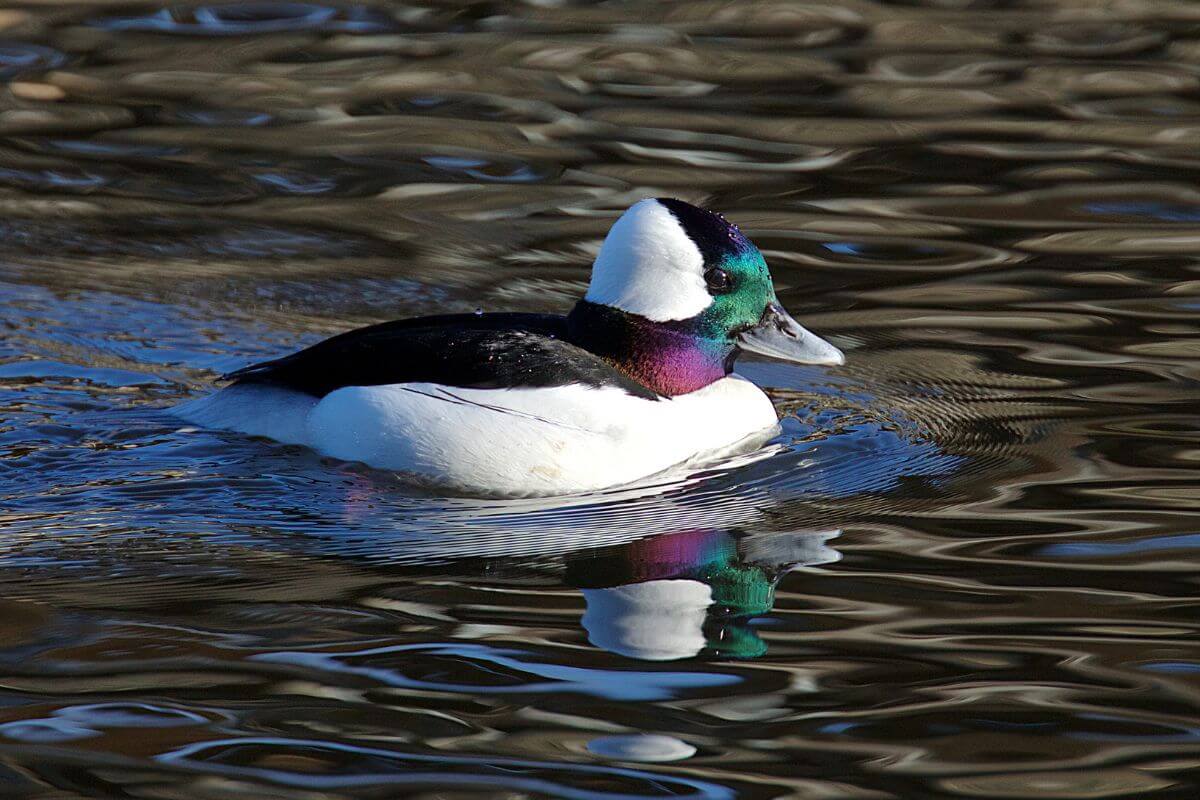
| Key Characteristics | Details |
|---|---|
| Scientific Name | Bucephala albeola |
| Habitat | Freshwater, permanent ponds, and small lakes |
| Food | Aquatic invertebrates (insects, crustaceans, mollusks) |
| Color | White and black to gray-brown |
A small yet striking waterfowl, the Bufflehead is a year-round resident of Montana. Male Buffleheads have a striking black-and-white appearance when seen from a distance. However, up close, you can also appreciate their glossy green and purple head feathers that enhance a vivid white patch. Female Buffleheads have a more muted gray-brown coloring, with a unique white patch on their cheeks.
Here are some fascinating facts that make the Bufflehead stand out even more:
- Nesting – Buffleheads have a peculiar choice of nesting spots, preferring holes made by Northern Flickers and occasionally Pileated Woodpeckers.
- Relationships – Buffleheads are almost always monogamous, a rare trait among ducks. It’s common for them to stick with the same mate for multiple years.
- Historical Significance – Fossils of the Bufflehead dating back to the late Pleistocene (about 500,000 years ago) have been discovered in various places, including Alaska, California, and Florida. This not only shows their long life history but also their ability to adapt and survive over time.
Buffleheads are ducks that are usually spotted during migration and winter. They tend to head to southern coasts and large water bodies, particularly shallow saltwater bays.
These ducks have a unique feeding habit where they forage underwater by diving, spending almost half their time beneath the surface. Scanning the waters patiently is important if you are looking out for Buffleheads.
12. Canvasback
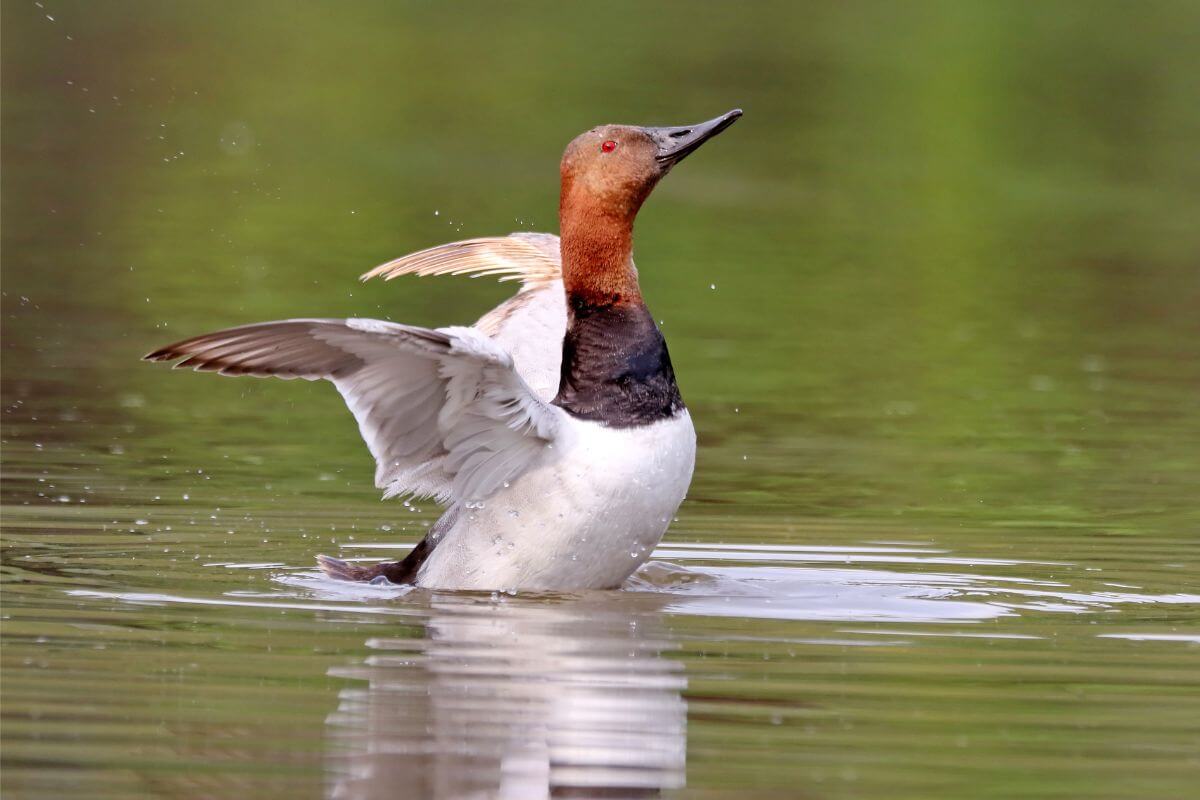
| Key Characteristics | Details |
|---|---|
| Scientific Name | Aythya valisineria |
| Habitat | Small lakes, deep-water marshes, ponds, sloughs |
| Food | Plants, small clams, and snails |
| Color | White, black, and chestnut to pale brown and gray |
Canvasbacks in Montana are around all year, but they love to show off during the summers from March to November. People often call themselves the aristocrats of ducks because of how they carry themselves. The Canvasback has a long, sloping forehead that keeps high, giving it a distinguished look.
Some cool facts about Canvasbacks:
- Exclusive – Canvasbacks can only be found in North America.
- Social – During the non-breeding season, Canvasbacks are super social and easy to see.
- Sneaky – Sometimes, female Canvasbacks play a sneaky game, laying their eggs in another Canvasback’s nest. Redheads and Ruddy Ducks might also do this in a Canvasback’s nest.
- Stands Out – You can’t miss male Canvasbacks with rusty heads, necks, and bodies that shine white with black tips. Female Canvasbacks are more subtly colored, pale brown all over.
In the continental U.S., spring, fall, and winter are prime times to see Canvasbacks. They love hanging out in big groups on open water. Their white bodies and unique head shape make them easy to spot, standing out from the crowd.
13. Greater Scaup
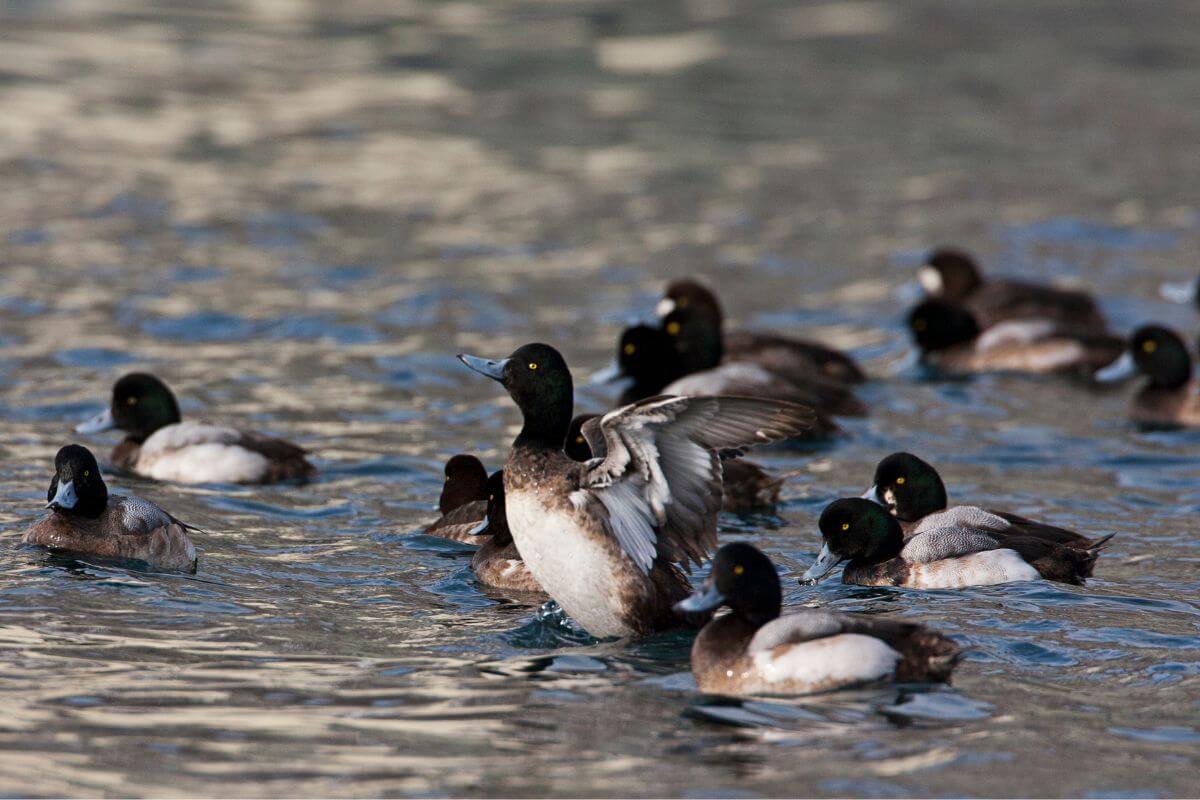
| Key Characteristics | Details |
|---|---|
| Scientific Name | Aythya marila |
| Habitat | Lakes, ponds, and reservoirs |
| Food | Snails, crustaceans, aquatic insects, seeds |
| Color | Black and white to brown |
Greater Scaups in Montana are uncommon but can be spotted from October to May. They share a lot of looks with the Lesser Scaup, their close relative. The key difference? It’s all about the head: the Greater Scaup rocks a rounded head, while the Lesser Scaup’s head is more like a peak.
Here are some cool facts about the Greater Scaup that might interest you:
- Arctic Dwellers – Greater Scaups are the only circumpolar diving duck. This means they breed in places with really cold climates, like the tundra regions in North America and Europe.
- Serious Nesters – Momma Scaups take nesting very seriously. They line their nests with a thick layer of down feathers plucked from their chests, keeping their eggs warm.
- Baby Preys – Life is tough for baby Scraups. They have a lot of predators to watch out for. Gulls, foxes, ravens, and, in some places, even big fish like northern pike see them as a tasty snack.
If you hope to glimpse a Greater Scaup, you might need to head towards the coast. They love hanging out in coastal waters during the winter. When it’s migration time, they’re all about the big lakes, like the Great Lakes, but once winter sets in, they prefer the coast.
14. Lesser Scaup

| Key Characteristics | Details |
|---|---|
| Scientific Name | Aythya affinis |
| Habitat | Lakes and ponds |
| Food | Mainly aquatic invertebrates, and plant material |
| Color | Black and white to brown |
The Lesser Scaup is a familiar sight in Montana, which can be seen throughout the state throughout the year but is especially noticeable during migration. They are one of North America’s most widespread and abundant diving ducks, with a global population of 3.8 million.
Here are some quick facts to remember about the Lesser Scaup:
- Appearance – When you first spot a flock of Lesser Scaups from a distance, you might mistake them for floating vegetation. But as you get closer, you’ll see the striking black-and-white males and chocolatey-brown females.
- Nesting – Female Lesser Scaups are different from many other diving ducks in how they build their nests on the ground near or over water and in upland areas.
- Acrobatic Behavior – You’ll see the Lesser Scaup twisting and turning in the water in lakes rich with tiny crustaceans called amphipods. This behavior is how they catch these small creatures that attach to their feathers as they swim.
If you want to see Lesser Scaups, you should go to large lakes like the Great Lakes between September and March when they are not breeding. You can also find them in smaller wetlands.
15. Redhead
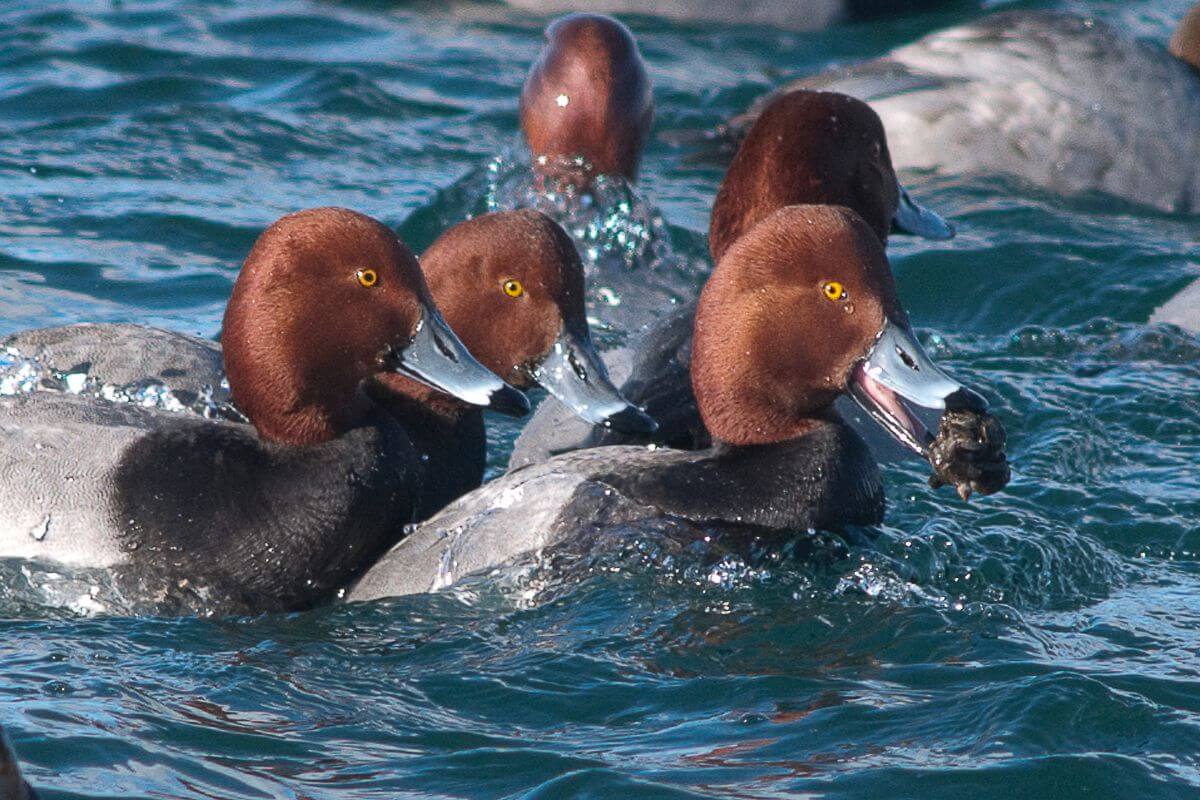
| Key Characteristics | Details |
|---|---|
| Scientific Name | Aythya americana |
| Habitat | Lakes and ponds, wetlands |
| Food | Vegetative parts and tubers of submerged aquatic plants |
| Color | Cinnamon, black, and gray to brown |
Redheads are a treat for Montana bird watchers because they stick around all year. This is unusual since most of the U.S. only sees them during migration and winter.
Here are some fascinating facts about Redheads that might surprise you:
- Egg Secret – Female Redheads are quite sneaky. They lay some of their eggs in the nests of other birds, including other Redheads. It’s like a hidden gift among friends, or in this case, other bird species.
- Head Throw Show – The male Redheads have a unique way of showing off. They do a head throw display that looks like a gymnastic move. It’s not just the bending nearly in half that’s impressive, but also the loud, catlike call they make.
- Socialites – Redheads are known for being super social. In fact, they’re called “rafting ducks” because they hang out in large groups on the water. They are so friendly that they might land near hunting decoys before hunters are ready, making an exciting sight for those interested in waterfowl during hunting season.
What makes Redheads stand out? The adult males are like beacons on the water with striking cinnamon heads. They’re easy to spot with their black and gray bodies. The females and young ones are more subtle, dressed in brown with the same cool-colored bill as the males.
16. Ring-Necked Duck
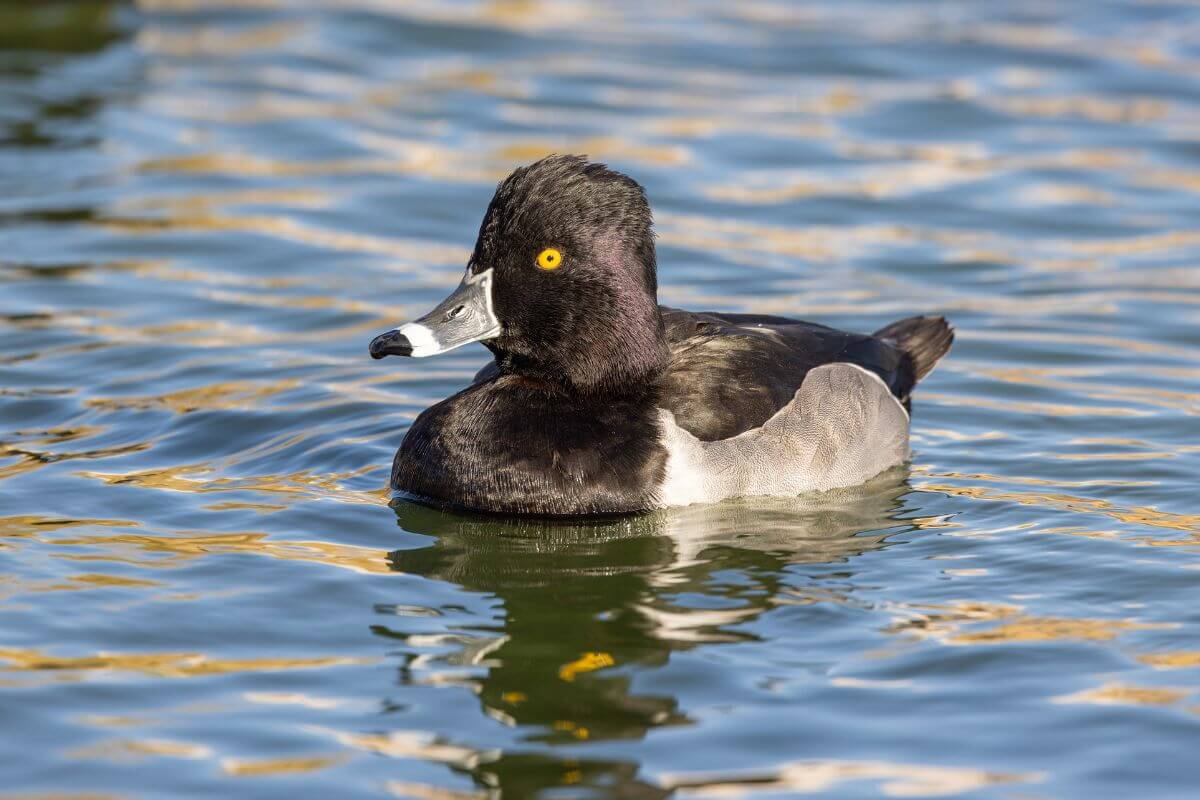
| Key Characteristics | Details |
|---|---|
| Scientific Name | Aythya collaris |
| Habitat | Freshwater wetlands, especially marshes, fens, and bogs |
| Food | Aquatic plant seeds and aquatic invertebrates |
| Color | Black, gray, and white to rich brown |
Spotting a Ring-Necked Duck in Montana is a treat for birdwatchers. These ducks are around all year, but they stand out during migration. If you’re looking to catch a glimpse, your best bets are from March to May and then again from October to November.
Now, let’s dive into some cool facts about these ducks:
- Loves Ponds – Among diving duck species, the Ring-Necked Duck is the most likely to visit small ponds during migration.
- Gets Attacked by Other Birds – Ring-Necked ducks occasionally get attacked by larger birds on their breeding grounds, such as the Common Loon, the Red-Necked Grebe, and the smaller Pied-Billed Grebe.
- Has a Collar – The name “Ring-Necked Duck” comes from the hard-to-see chestnut collar on its black neck. This feature is so subtle that it’s often overlooked, but it’s there.
Here’s a tip when looking for Ring-Necked Ducks: Forget looking for a ring around its neck. Instead, focus on the peaked head shape, the white ring near its bill, and the white patch close to its gray flanks.
17. Ruddy Duck
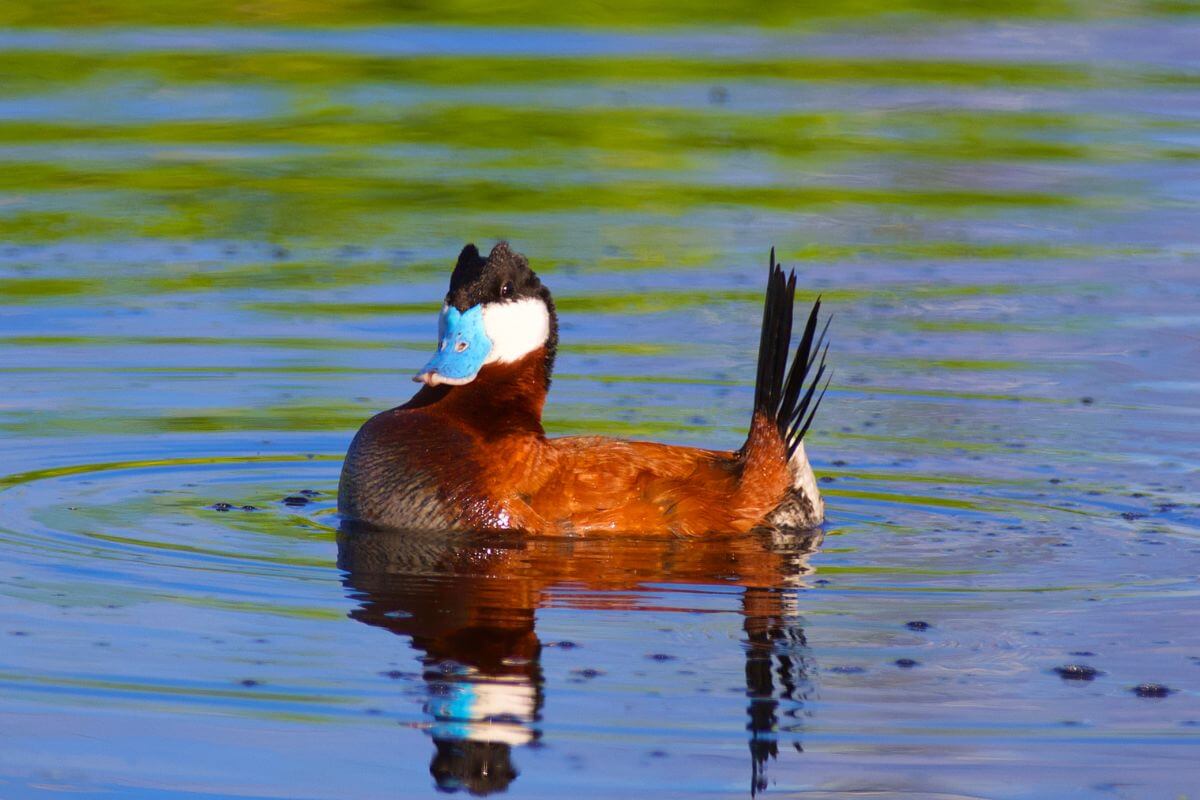
| Key Characteristics | Details |
|---|---|
| Scientific Name | Oxyura jamaicensis |
| Habitat | Overgrown, shallow marshes with vegetation |
| Food | Aquatic insects, crustaceans, zooplankton |
| Color | Black, white, and chestnut to brown |
Ruddy Ducks are a fascinating sight in Montana, with their compact and thick-necked ducks that are hard to miss. When their tails are held high, they give the impression of being oversized.
Key things to know about Ruddy Ducks include but are not limited to:
- Sightings – Ruddy Ducks are commonly seen on open water from fall through spring. In Montana, they are usually spotted from April to December.
- Unique Courtship – Male Ruddy Ducks attract female mates by forcefully tapping their bills against their necks, creating bubbles in the water.
- Egg Size – Ruddy Ducks lay the largest duck eggs relative to their body size. These eggs are big, white, and have a pebbly texture.
- Night Feeders – Ruddy Ducks are most active at night, which explains why you often find them sleeping during the day with their heads tucked and tails up.
Watching Ruddy Ducks offers a glimpse into unique behaviors, from their elaborate courtship to their nocturnal feeding habits. Watch for these compact ducks as you explore Montana’s waters.
Montana Sea Ducks
Montana’s sea ducks add a unique touch to the state’s waterfowl population. These ducks are specially adapted to marine and coastal environments, making them fascinating creatures to observe. Let’s dive into the world of Montana’s sea ducks and discover what makes them stand out.
18. Barrow’s Goldeneye
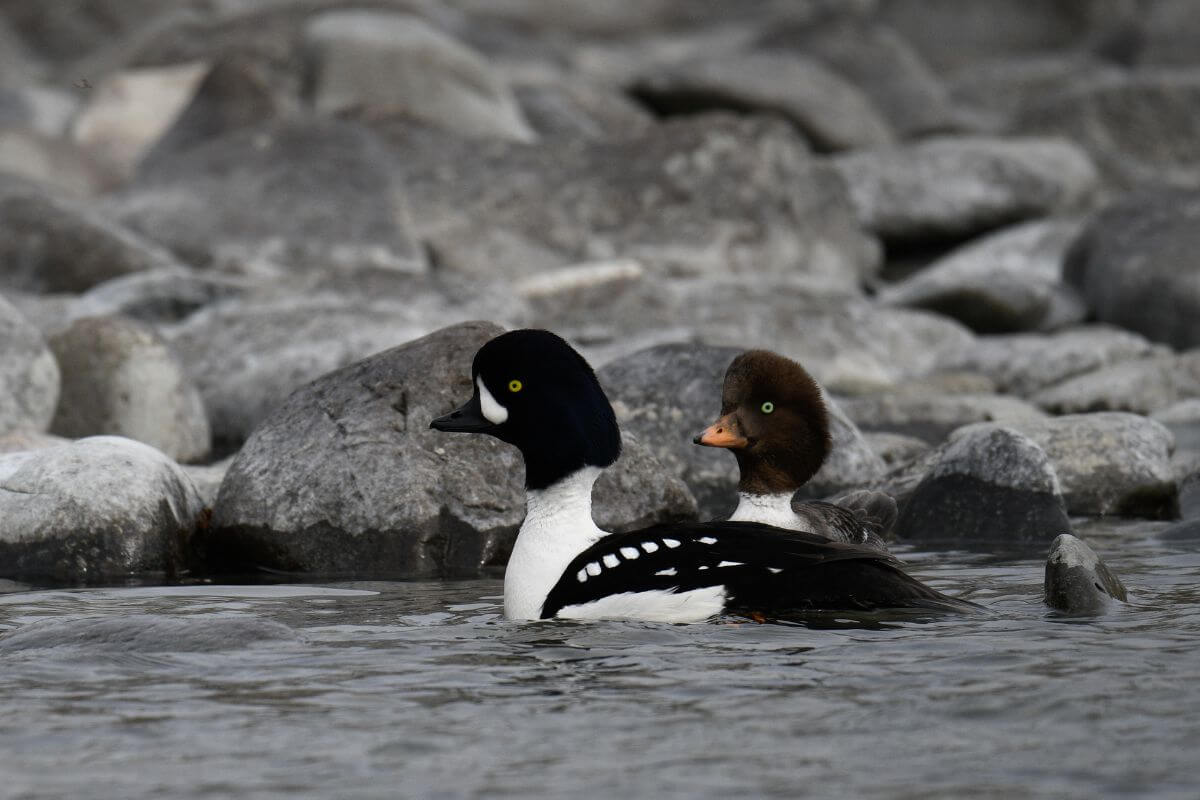
| Key Characteristics | Details |
|---|---|
| Scientific Name | Bucephala islandica |
| Habitat | Alkaline to freshwater lakes in parkland areas |
| Food | Aquatic invertebrates and fish eggs |
| Color | Black-and-white with purple to gray with brown |
Barrow’s Goldeneyes are a distinctive sight in Montana, especially in the western part of the state. These birds are true to the western montane region of North America, with their duck habitat primarily lying to the west of the Continental Divide.
Spotting a Barrow’s Goldeneye is a unique experience, depending on the season. In the summer, they can be found on small, tree-surrounded mountain lakes. Come winter, they move to rocky ocean coasts. They also inhabit inland lakes and rivers that don’t freeze, offering year-round birdwatching opportunities.
Here are some fascinating facts about Barrow’s Goldeneyes that make them stand out:
- Territorial – Barrow’s Goldeneyes are the most aggressive of the three Bucephala species. Both males and females are dedicated to defending their territories.
- Loyal – Female Barrow’s Goldeneyes that have bred before show a strong attachment to their previous nest sites.
- Occasional Hybrid – While there is some chance of hybridization with Common Goldeneyes, it’s not common. This highlights the uniqueness and importance of preserving the duck habitat of Barrow’s Goldeneyes.
When you’re out looking for these goldeneyes, focus on their features. Scan duck groups for the almost triangular shape of their heads. This, along with specific characteristics like bill size, forehead shape, and the male’s facial crescent, helps you tell them apart from Common Goldeneyes.
19. Black Scoter
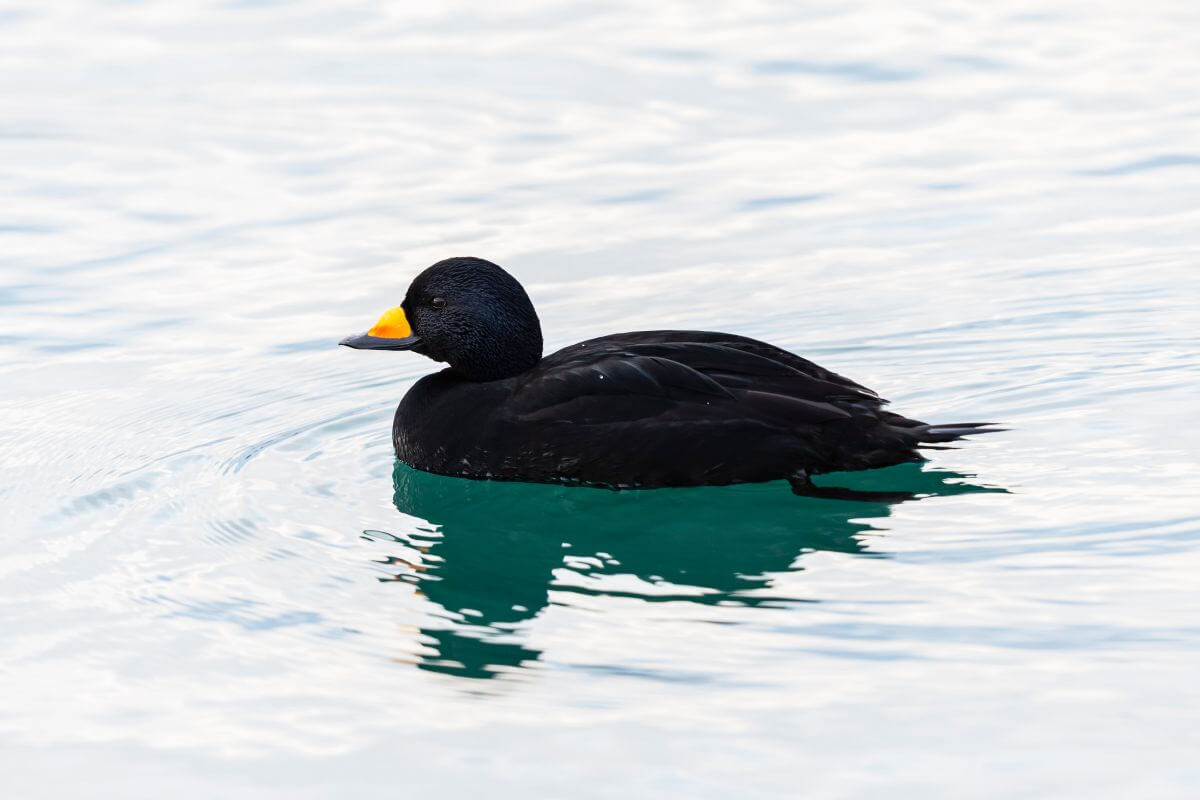
| Key Characteristics | Details |
|---|---|
| Scientific Name | Melanitta americana |
| Habitat | Oceans |
| Food | Aquatic invertebrates |
| Color | Black to brown with an orange knob |
The Black Scoter is rare in Montana, making its way here by accident. Even though they are sea ducks, you can find them briefly on inland lakes and reservoirs. When the weather gets tough, they seek refuge in calmer waters.
Here are some cool facts about the Black Scoter:
- Vocalizations – Black Scoters are among the loudest and most talkative. The males’ constant crooning is a melancholic whistling sound that fills the air. It’s a bit like they’re singing the blues of the vast, lonely seas they come from.
- Whistling Behavior – Black Scoters make whistling sounds with their wings, and males often give whistled calls.
- Unique Display – Black Scoters occasionally perform a unique display while swimming, flapping their wings while their bodies are held up from the water.
You might spot Black Scoters during the fall and early winter. This duck is easy to spot, with the male being a deep black seaduck and a bright orange knob near its bill. The female, on the other hand, is mostly brown but has a unique face pattern.
20. Common Goldeneye
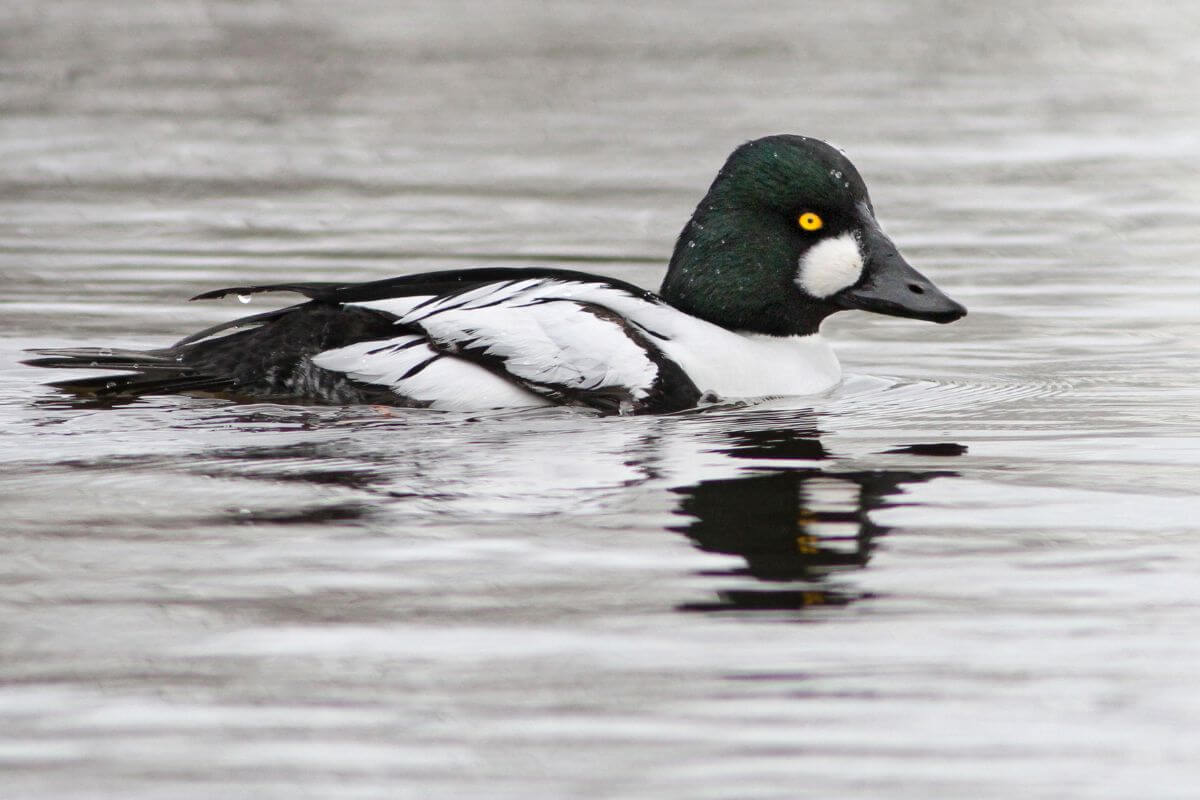
| Key Characteristic | Details |
|---|---|
| Scientific Name | Bucephala clangula |
| Habitat | Forested wetland habitats |
| Food | Aquatic invertebrates |
| Color | Mostly black and white |
Seeing a Common Goldeneye in Montana is a special winter treat. From November to April, these medium-sized ducks stand out with big heads and bright yellow eyes. They are built for diving, with sleek bodies and short tails.
Let’s dive into some cool facts about the Common Goldeneye:
- Whistler Wings – Waterfowl hunters named Common Goldeneyes “whistler” because of their wings’ unique whistling sound in flight.
- Egg Tricks – Female Common Goldeneyes are known to lay eggs in the nests of other Common Goldeneyes, especially in nest boxes.
- Home Choices – When they’re not laying eggs in other nests, Common Goldeneyes build nests in tree cavities and nest boxes. The female prepares a cozy spot with down feathers.
Meeting a Common Goldeneye in Montana’s winter is a memorable experience. They are found on larger water bodies, often in flocks. Listen for the whistling sounds as they fly and admire their physical characteristics.
21. Common Merganser
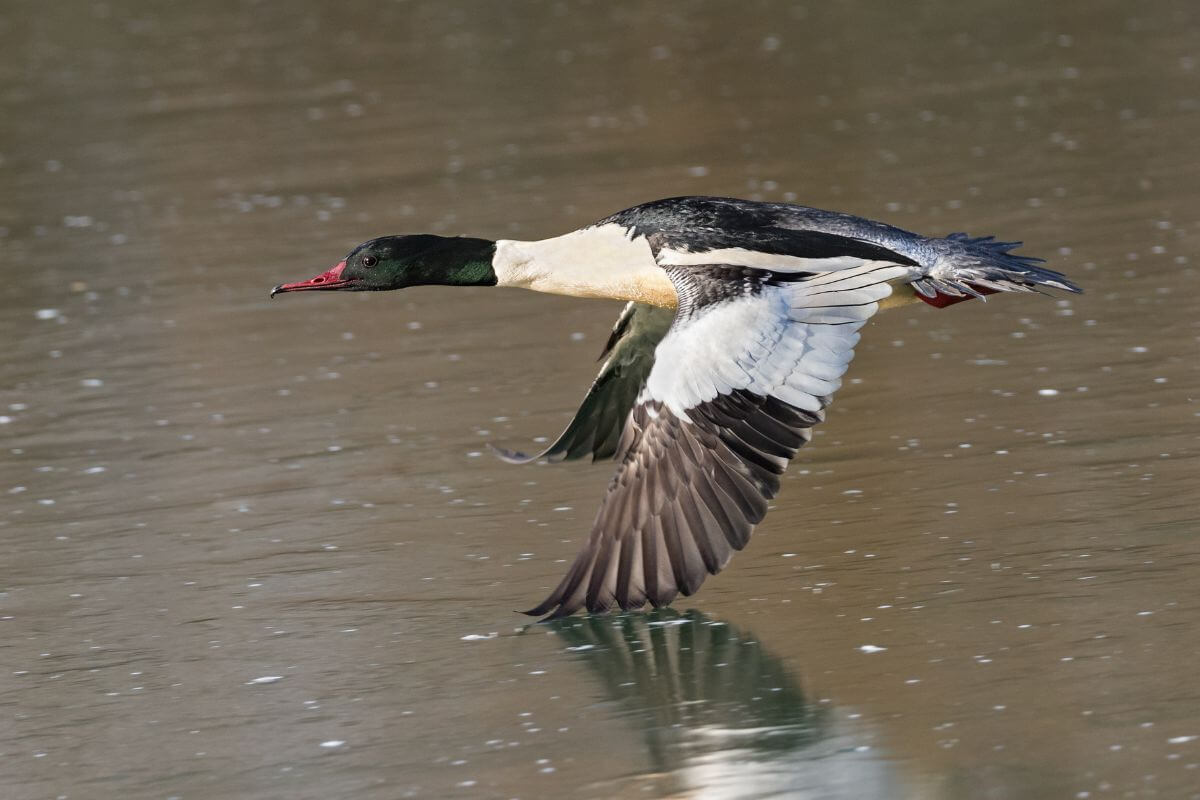
| Key Characteristic | Details |
|---|---|
| Scientific Name | Mergus merganser |
| Habitat | Large lakes and large rivers |
| Food | Small fish |
| Color | White bodies and dark, iridescent-green heads |
The Common Merganser is quite the sight on Montana’s waterways. These ducks are built for elegance and speed, perfect for gliding along calm rivers and near the shore. They stand out with their long bodies, sleek shapes, and distinctive bills.
Here are some fascinating facts about these unique ducks:
- Nesting – Common Mergansers opt for cozy spots, often using natural tree hollows or holes made by large woodpeckers.
- Feeding – Even though their moms keep them safe, Common Mergansers chicks are quite independent and learn to dive for their own food. They start with insects and move on to fish, showing their adaptability early on.
- Nicknames – Common Mergansers have a few nicknames that highlight their eating habits and distinctive bills. They are called sawbills, fish ducks, and goosanders.
You can spot Common Mergansers in Montana all year round, whether perched on rocks in the middle of a stream or just around the river’s bend. They’re easily recognizable, swiftly flying with their white wing patches visible.
22. Harlequin Duck
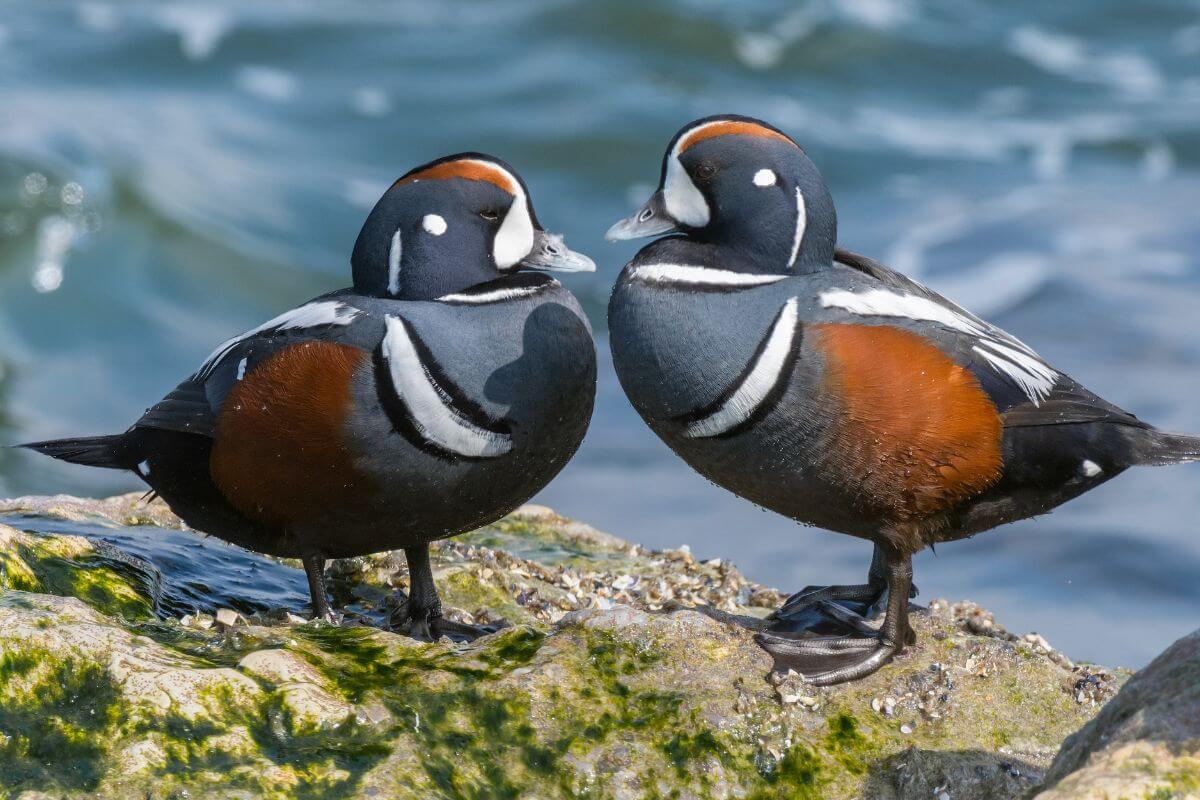
| Key Characteristics | Details |
|---|---|
| Scientific Name | Histrionicus histrionicus |
| Habitat | Mountain streams |
| Food | Young and adult aquatic insects and fish roe |
| Color | Blue, chestnut, and white to grayish |
The Harlequin Duck is a treasure of Montana, signaling the state’s unique and rugged landscapes. This duck is known for its vibrant plumage and thrives in the most challenging environments, making it a sight not to be missed for any nature enthusiast.
Here are some key points to know about the Harlequin Duck:
- Breeding Habitat – The Harlequin Duck is very selective about where it nests. In Montana, you’ll find them breeding exclusively in the fast, clear waters of mountain streams in the western part of the state.
- Hangout Spots – Harlequin Ducks are not just about looks. They flair for the dramatic, choosing rocky shores with big waves as their hangout spots. Despite the rough conditions, you can spot them bobbing in small groups or resting on sunlit rocks near shore.
- Unique Traits – The Harlequin Duck’s uniqueness goes beyond its choice of home. The duck is remarkable for its vocalizations. Both males’ and females’ duck sounds are more like a mouselike squeak than a quack. This distinctive feature sets them apart in the world of waterfowl.
- Conservation Status – Important wildlife management entities recognize the Harlequin Duck as a sensitive species, so it is protected to ensure its survival and the preservation of its habitat.
- Tough Life – Living in such harsh environments takes its toll. Many Harlequin Ducks suffer broken bones from the rough waters, highlighting their challenges just to exist.
Encountering a Harlequin Duck in Montana is a special experience, offering a glimpse into the resilience and beauty of nature. Remember to observe from a respectful distance, appreciating these magnificent creatures in their wild and untamed habitat.
23. Hooded Merganser
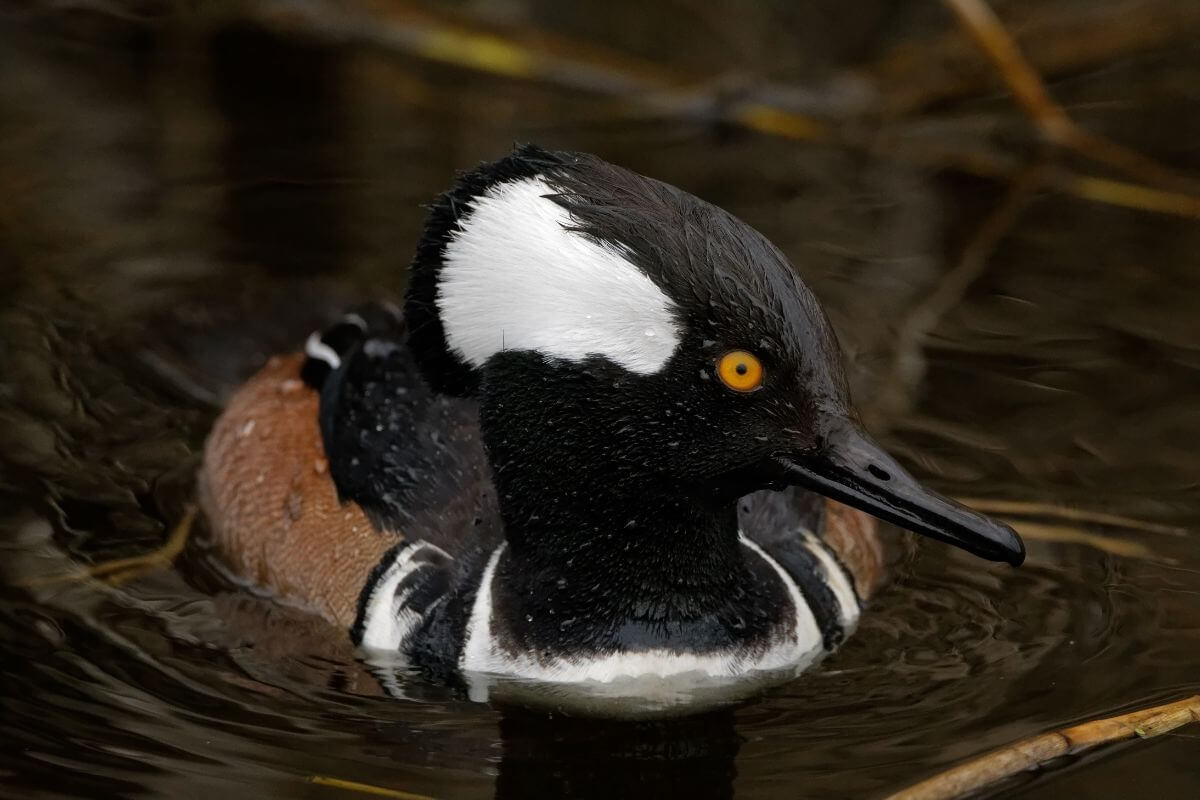
| Key Characteristics | Details |
|---|---|
| Scientific Name | Lophodytes cucullatus |
| Habitat | Forested wetland systems |
| Food | Aquatic insects, fish, and crustaceans |
| Color | Black, white, chestnut to gray, brown, cinnamon |
The Hooded Merganser is a standout duck in Montana, known for its unique features and habits. These small ducks sport a thin bill and a remarkable fan-shaped crest that they can collapse. This ability gives it an exciting look, making its head appear unusually large and oblong.
Here are some key points to remember about the Hooded Mergansers:
- Small Size – Hooded Mergansers are the second-smallest among all living merganser species, with only the Smew from Eurasia being tinier. They are also the only merganser species restricted to North America.
- Unique Colors – Adult male Hooded Mergansers are easy to spot, black on top with a white breast and rich chestnut-colored sides. Females and young ducks have shades of gray and brown, with tawny-cinnamon tones on their heads.
- Contrasting Features – Unlike other mergansers, Hooded Mergansers are smaller, have distinctive white head patches (for males), and lack a red bill. They also differ from Buffleheads in that they do not have white sides.
- Exceptional Sight – Hooded Mergansers use their keen sight to hunt underwater, which sets them apart from other diving ducks.
Hooded Mergansers are found in unfrozen lakes and shallow, protected saltwater bays from fall through spring. They tend to hang out with other small diving ducks, such as Buffleheads and Ruddy Ducks.
24. Long-Tailed Duck
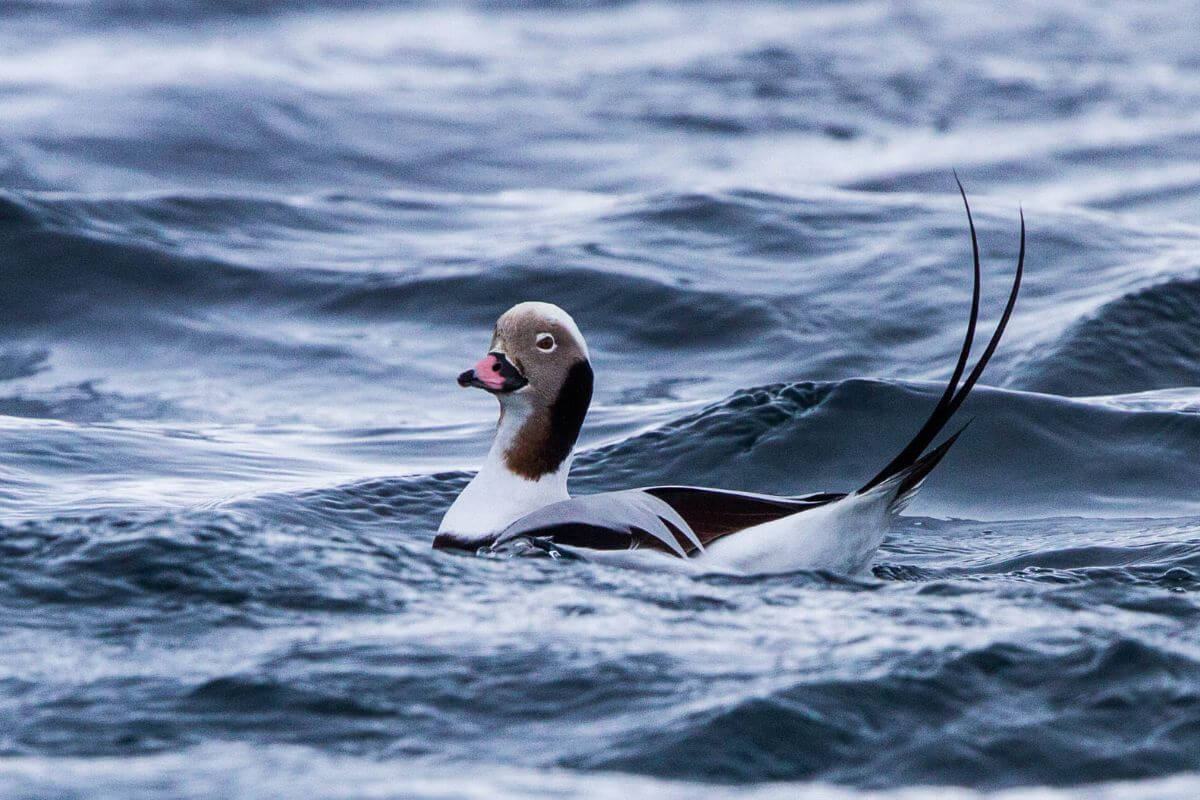
| Key Characteristics | Details |
|---|---|
| Scientific Name | Clangula hyemalis |
| Habitat | Reservoirs, lakes, or large rivers |
| Food | Grains, grasses, and agricultural crops on land |
| Color | Mostly white and black or with brown |
The Long-Tailed Duck is rare in Montana, with fewer than 16 observations in a typical year. These ducks are considered vulnerable in the state, particularly during winter when they are known to visit.
Identifying a Long-Tailed Duck is an exciting challenge. These small sea ducks have distinctive features: a slender body, a rounded head, and a small bill. The male is recognized by its long tail plumes, a feature present for most of the year.
Here are some fascinating facts about Long-Tailed Ducks that make them stand out:
- Amazing Divers – Long-Tailed Ducks can dive as deep as 200 feet for food.
- Underwater Experts – Long-Tailed Ducks spend the most time underwater among all diving ducks.
- Extravagant Tails – Long-Tailed Ducks’ tail feathers are long and slender regardless of the plumage.
Winter is the key season for those looking to spot a Long-Tailed Duck. These slender ducks migrate to the Great Lakes and protected bays along the coasts. Weather and sea-ice conditions push the ducks closer to shore here, making their yodeling calls easier to hear.
25. Red-Breasted Merganser

| Key Characteristics | Details |
|---|---|
| Scientific Name | Mergus serrator |
| Habitat | Large lakes, ponds, and rivers |
| Food | Fish |
| Color | Green, white, cinnamon to brownish gray |
Spotting a Red-Breasted Merganser in western Montana during migration is a special treat. While they can be seen throughout the year, the best time to catch them in Montana is during winter. This is when they glide through sheltered estuaries and bays.
Here are some fascinating facts about these diving ducks:
- Diet – Red-Breasted Mergansers are not light eaters. To keep their energy up, they dive for fish and need to eat 15 to 20 of them every day.
- Habitat Choice – Unlike some relatives, Red-Breasted Mergansers strongly prefer saltwater, making coastal areas their primary hangouts.
- Nickname – Named for their uniquely designed bills, these sawbill ducks are known for their fishing skills. They use their thin, serrated bills to catch and hold onto slippery fish.
- Appearance – Due to their similar appearance, females and non-breeding male Red-Breasted Mergansers might be mistaken for Common Mergansers. However, the Red-Breasted Merganser’s choice of habitat sets them apart.
Red-Breasted Mergansers’ distinctive shaggy crest adds to their unique profile, making them easily recognizable. Remember to bring your binoculars and watch the water if you’re out looking for them.
26. Surf Scoter
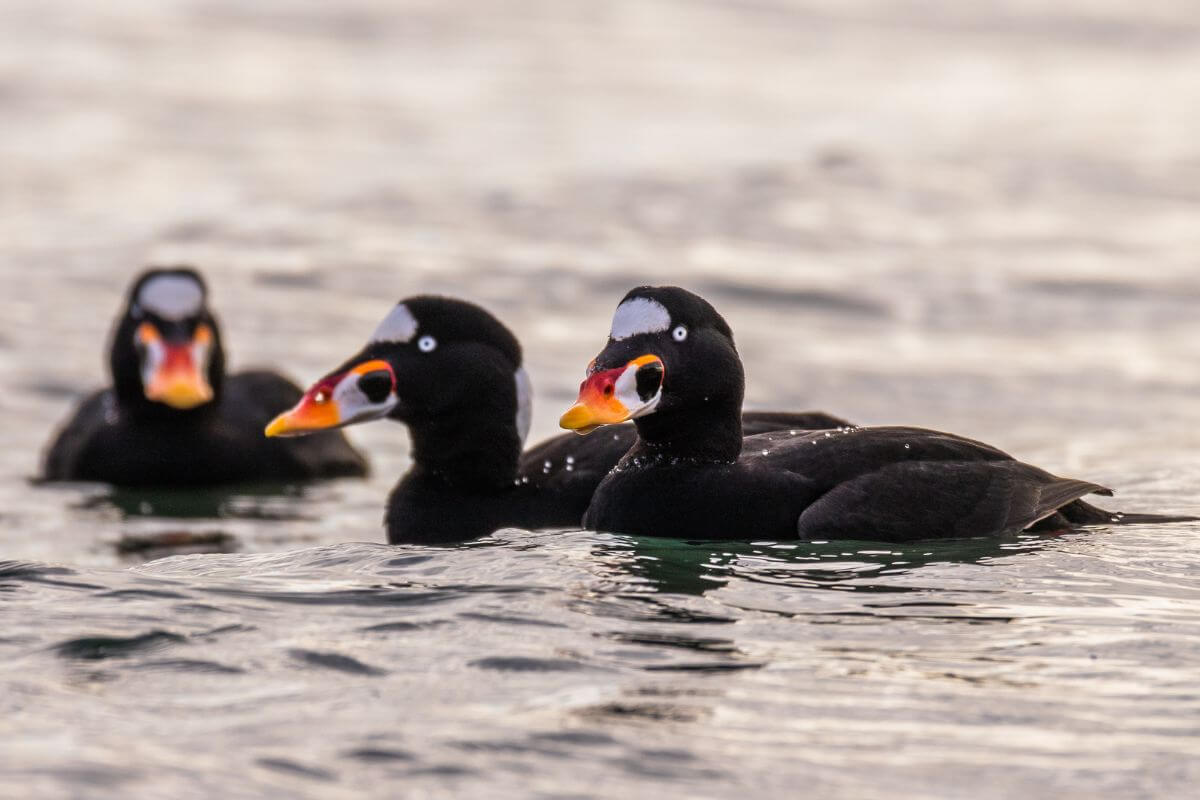
| Key Characteristics | Details |
|---|---|
| Scientific Name | Melanitta perspicillata |
| Habitat | Oceans, large lakes, and reservoirs |
| Food | Grains, grasses, and agricultural crops on land |
| Color | Black-and-white to brown |
The Surf Scoter is an uncommon migrant in Montana, with fewer than 9 observations reported in a typical year. They visit Montana during fall migration, braving the waves near shore from September to December.
These sea ducks get their nickname, “old skunkhead,” from the black-and-white patches on the males’ heads. But it’s their big, sloping orange bill that really stands out.
Here are some fascinating facts about the Surf Scoter:
- Molt Migrants – Surf Scoters are known as “molt migrants” because adults fly to specific areas to molt their flight feathers after nesting.
- Inland Visitors – Despite their love for the sea, Surf Scoters can be found on inland lakes and reservoirs during migration, especially during storms. Flocks of thousands of these ducks can be seen during migration along ocean coasts.
- Brood Switchers – On busy lakes, it’s common to see young Surf Scoters switching from duck broods to others.
Surf Scoters bring a unique touch to Montana’s waterfowl scene, adding a dash of the sea to the state’s natural beauty.
27. White-Winged Scoter
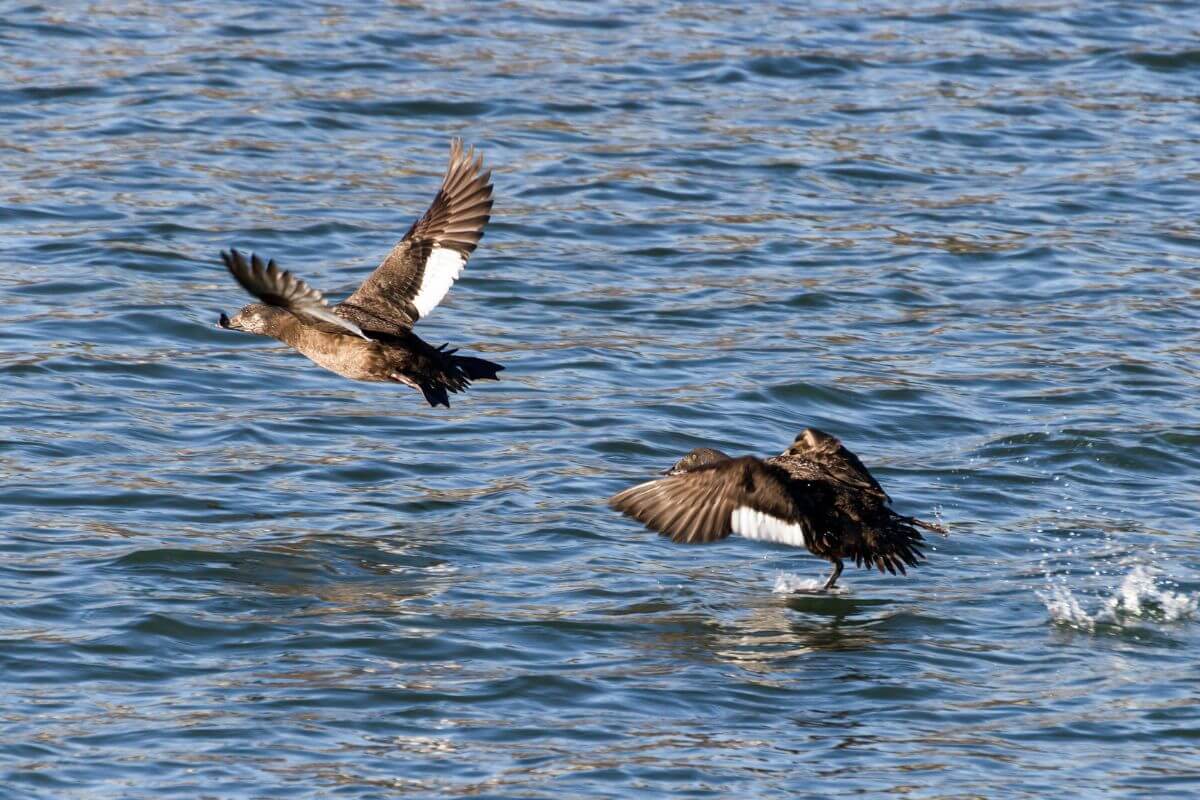
| Key Characteristics | Details |
|---|---|
| Scientific Name | Melanitta deglandi |
| Habitat | Lakes and ponds |
| Food | Aquatic invertebrates |
| Color | Silken black overall with large white patches |
Montana welcomes the White-Winged Scoter as a rare winter guest. Known for its robust size and distinctive markings, this sea duck is a sight. Despite being an uncommon visitor, with fewer than 6 sightings a year, the White-Winged Scoter stands out in the state’s waterfowl community.
Here are some fascinating facts about the White-Winged Scoter that make it even more intriguing:
- Diet – White-Winged Scoters have a hearty appetite for mussels, a diet that requires them to dive deep and hold their breath for over a minute.
- Rarity – White-Winged Scoters are the scarcest of the three scoter species in North America. They also outsize other scoter species.
- Nesting Habits – White-Winged Scoters have a clever nesting strategy, often choosing spots near gull colonies. Despite the risk of gulls eating their eggs and chicks, the dense vegetation around their nests keeps them safe.
During winter, you’ll find these magnificent birds in large mixed flocks of sea ducks along the Atlantic and Pacific coasts. Look for them near rocky shorelines or sandbars. They stand out as large, bold sea ducks with white patches on their wings.
Montana Ducks Final Thoughts
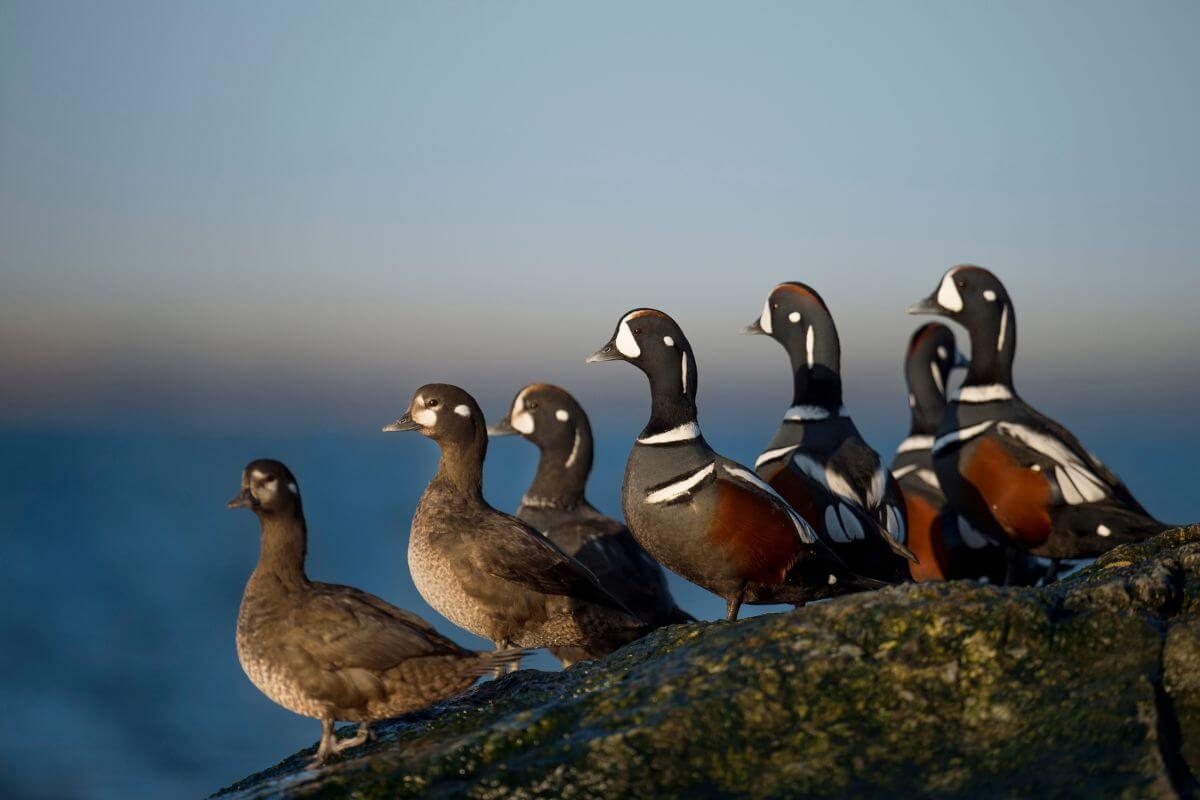
Montana’s skies and waters are alive with duck residents’ vibrant colors and unique features. From year-round puddle ducks like the Mallard to rare and special guests like the Eurasian Wigeon. Each duck fascinates the state’s landscape.
Thanks to Montana’s diverse habitats, both seasoned and new birdwatchers can witness a dynamic range of species. Knowing when and where to look enriches the experience. It also emphasizes the importance of preserving these natural spaces for future generations of ducks and duck enthusiasts.
Whether it’s Gadwalls’ daring habits or the Cinnamon Teal’s striking colors, each duck offers a new tale. Embrace the beauty and complexity of nature as you spot these local treasures. And remember, every sighting is a moment to cherish and a call to protect our shared environment.
Montana Ducks FAQs
1. What Kind of Ducks Live in Montana?
Various duck species live in Montana, including dabblers like the mallard, northern pintail, gadwall, and American wigeon. These ducks feed by tipping in shallow waters such as wetlands and agricultural fields.
Additionally, divers like the canvasback and redhead are associated with larger bodies of water, such as lakes and rivers, where they dive down to feed.
2. Is Montana Duck Hunting Good?
Montana is considered a fine destination for waterfowl hunting. It offers plentiful duck populations, ample opportunities for public hunting, vast expanses of solitude in the big country landscape, and ducks migrating through two flyways.
Moreover, waterfowl hunters can enjoy excellent goose hunting as a bonus, making Montana an attractive choice for waterfowl enthusiasts.
3. Are There Harlequin Ducks in Montana?
Although not widespread throughout the state, Glacier National Park’s Upper McDonald Creek boasts the highest density of breeding harlequin ducks in the contiguous United States, making it a notable location for observing this species.
4. What Waterfowl Are Black and White in Montana?
Montana’s most notable black and white waterfowl species are the common merganser and the bufflehead. These striking birds can be found in various aquatic habitats throughout the state, including rivers, lakes, and wetlands, adding contrast and beauty to Montana’s diverse waterfowl populations.
5. What Is the Duck Limit in Montana?
In Montana, the daily bag limit for ducks or mergansers is 7. However, this limit includes specific restrictions: no more than 2 hen mallards, 1 pintail, 2 redheads, 2 canvasbacks, and 2 scaup can be included in the daily bag.
Discover other fascinating facts about Montana through the articles below:
- https://fieldguide.mt.gov/displaySpecies.aspx?family=Anatidae
- https://www.nps.gov/articles/harlequin-ducks.htm
- https://fwp.mt.gov/binaries/content/assets/fwp/montana-outdoors/duckid.pdf
- https://www.fws.gov/refuge/northwest-montana-wetland-management-district/species
- https://animalrangeextension.montana.edu/wildlife/private_land_wildlife_mgmt/waterfowl-mgmt.html
- https://www.flickr.com/photos/sussexbirder/13667530455/

